The Beatles live: Festival Hall, Brisbane, Australia
The Beatles’ 1964 world tour ended on 30 June 1964, with two shows at the Festival Hall in Brisbane. Each of the concerts was seen by 5,500 fans.
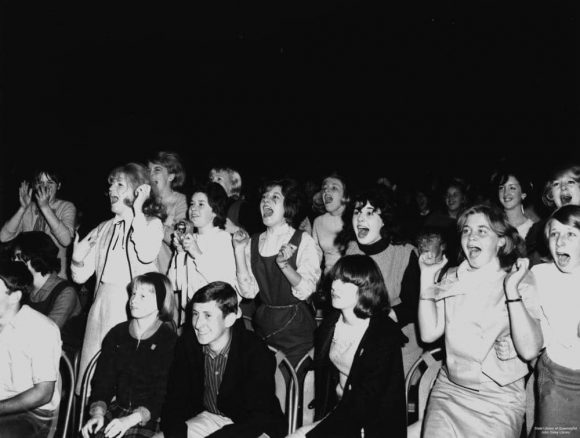
During the day they took two hire cars to the Gold Coast, where they spent time relaxing on a stretch of sand between Broadbeach and Surfers Paradise.
The Beatles returned to Lennons Hotel in Brisbane after their second concert of the night. The following day they began their long return journey back to England.

Also on this day...
- 2016: Paul McCartney live: Rock Werchter
- 2000: Ringo Starr and his All-Starr Band live: Taste of Minnesota 2000, Saint Paul
- 1990: Paul McCartney live: Knebworth Festival
- 1968: Paul McCartney records Thingumybob by Black Dyke Mills Band
- 1966: The Beatles live: Nippon Budokan Hall, Tokyo
- 1965: The Beatles live: Palais des Expositions, Nice, France
- 1963: The Beatles live: ABC Cinema, Great Yarmouth
- 1962: The Beatles live: Heswall Jazz Club, Wirral
- 1961: The Beatles live: Top Ten Club, Hamburg
- 1960: The Silver Beetles live: The Institute, Neston, Wirral
Want more? Visit the Beatles history section .
Latest Comments
I saw the Beatles at Festival Hall for the first concert. I was at Qld Uni at a College and we queued for 2 days to get tickets. Couldn’t hear much because of the screaming. A group from our College wanted to get a name for ourselves so, stupidly we decided we would throw eggs at the Beatles at the Airport. Young and stupid. The poor Beatles thought that this would start a fad similar to girls throwing their panties at Tom Jones. It was in all the papers
I was there too, as a well-behaved 17-year-old, I think for the later concert, and with my sister and a workmate rather than with a group of morons posing as university students.
Not being an idle and well-funded student of independent means I was unable to dodge lectures (I was attending UQ part-time and went to all my lectures after a day’s work, as humble people did in those days because the taxpayer didn’t pick up the tab and most of didn’t have rich parents or win Commonwealth Scholarships, which were very scarce and required well-heeled parents anyway).
My mother queued for the tickets for us, and although it was a marvellous, selfless thing for her to do, it was more like two hours than two days; no one queued for two days. We had good seats too, although it’s true that you couldn’t hear anything because of the screaming young females (plus perhaps the cretinous full-time male university “students” making their recently-broken voices heard).
The Beatles certainly did not think that throwing eggs at them (and yes it was a very, very (how many verys may I include?) stupid thing to do) would start a trend, nor was it in all the papers. How extraordinary and cringeworthy that you and your cohort thought it a good idea.
Katter, as the son of a Commonwealth parliamentarian did throw eggs at The Beatles at the airport, and bad cess to him for having done so.
Young and stupid, eh? Is that supposed to be a defence?
We were all young, but we weren’t all stupid; perhaps you had to be well-off and young to be stupid? Most people were sensible in 1964; I remember it well.
I do hope you’re not an “eminent” jurist, parliamentarian, medical man or anything moderately important, Eddie, because your confession that you spent your university time as a fool is most distressing.
You are now at least as old as I am Eddie, but throwing eggs at The Beatles is up there with tripping the Queen.
Have you ever done that?
Leave a Reply
- Today's news
- Reviews and deals
- Climate change
- 2024 election
- Fall allergies
- Health news
- Mental health
- Sexual health
- Family health
- So mini ways
- Unapologetically
- Buying guides
Entertainment
- How to Watch
- My watchlist
- Stock market
- Biden economy
- Personal finance
- Stocks: most active
- Stocks: gainers
- Stocks: losers
- Trending tickers
- World indices
- US Treasury bonds
- Top mutual funds
- Highest open interest
- Highest implied volatility
- Currency converter
- Basic materials
- Communication services
- Consumer cyclical
- Consumer defensive
- Financial services
- Industrials
- Real estate
- Mutual funds
- Credit cards
- Credit card rates
- Balance transfer credit cards
- Business credit cards
- Cash back credit cards
- Rewards credit cards
- Travel credit cards
- Checking accounts
- Online checking accounts
- High-yield savings accounts
- Money market accounts
- Personal loans
- Student loans
- Car insurance
- Home buying
- Options pit
- Investment ideas
- Research reports
- Fantasy football
- Pro Pick 'Em
- College Pick 'Em
- Fantasy baseball
- Fantasy hockey
- Fantasy basketball
- Download the app
- Daily fantasy
- Scores and schedules
- GameChannel
- World Baseball Classic
- Premier League
- CONCACAF League
- Champions League
- Motorsports
- Horse racing
- Newsletters
New on Yahoo
- Privacy Dashboard
A New Book About The Beatles’ 1964 Australian Tour Is Coming
Australian publishing house Woodslane Press have announced a new book entitled When We Was Fab: Inside The Beatles ‘ Australasian Tour 1964 . As its title suggests, the book documents the first and only time that The Beatles ever came to Australia and New Zealand in June of 1964. Its release on Saturday, June 1st will fall on the eve of the tour’s 60th anniversary.
When We Was Fab was written by music historian Andy Neill and radio presenter Greg Armstrong. The former is a published author of biographies of The Who and Rod Stewart , having also published two Beatles photo anthologies. The latter, meanwhile, is the host of the Melbourne-based Let It Be Beatles , which is described as “the world’s longest-running weekly live radio show dedicated to The Beatles”.
The book is a comprehensive look at the tour, which saw 30,000 people line the streets of Adelaide to welcome the band to the city and Beatlemaniacs flooding the airport in Sydney and Melbourne upon their arrival. It compiles never-before-seen photographs, press clippings, interviews and eye witness recollections from over 100 people that either saw or participated in the band’s visit.
The Beatles – 1964 Australian Tour Highlight Reel
The tour was also notable for the partial absence of drummer Ringo Starr . Struck with tonsilitis before the start of the tour, he was replaced by unknown session drummer Jimmie Nicol for eight shows of the band’s world tour – including two performances in Adelaide. Starr officially rejoined his bandmates when they arrived in Melbourne, to perform at the city’s Festival Hall for six shows.
Although John Lennon never returned to Australia again prior to his death in 1980, the three remaining Beatles all returned. Paul McCartney toured Australia with Wings in 1975 and returned for a solo tour in 1993. He would not come back until 2017 , however, which was later followed by the Got Back stadium tour in October of last year.
Starr, meanwhile, would not return to Australia for 49 years after the 1964 shows. He eventually came back to Australia in 2013, performing shows with his All-Starr Band across the country. As for George Harrison , the dark-horse Beatle never toured Australia again but did have a holiday home on Hamilton Island known as Letsbeavenue. The home was built in the 80s, with Harrison visiting Australia for the final time in 2000 before his death the following year.
Pre-orders for When We Was Fab: Inside The Beatles’ Australasian Tour 1964 are on sale now via Woodslane Press .
Further Reading
Paul McCartney Review – Beatles, Wings and a Lifetime of Memories in Sydney
Paul McCartney 2023 Australian ‘Got Back’ Tour Setlists
The Beatles Release Their Final Song ‘Now And Then’
The post A New Book About The Beatles’ 1964 Australian Tour Is Coming appeared first on Music Feeds .
Recommended Stories
Steam closes an early-access loophole in its refund policy.
Valve has closed a loophole in its refund policy that let users play many hours of a game before its official release and still get their money back.
Rivian offering up to $5,000 discount to some BMW, Jeep, and Toyota owners
Rivian is targeting owners of a truck or SUV comparable to its R1T and R1S models by offering a trade-in bonus of up to $5,000 and free charging.
NFL Draft is a showcase not only for players, but for Detroit and its progress
In some cities, hosting the NFL Draft is just that — a fun, unique three-day event that has toured the country since 2016. For Detroit, it was seen as something more.
Fantasy Baseball Trade Analyzer: It might be time to sell low on Corbin Carroll
Fantasy baseball analyst Fred Zinkie offers up some big-picture trading tips before April wraps up, along with some key players to make moves on.
Diddo’s new funding will bring its shoppable TV API to streaming platforms
Diddo is an API for streaming services and other platforms to integrate shoppable video, enabling consumers to buy their favorite characters' clothing and accessories directly on their screens. The company announced Wednesday that it raised $2.8 million in seed funding. Diddo was founded in late 2022 by Rishi Nair, Ryan Sullivan, and Pamela Chen.
Meta Q1 earnings preview: Ad growth and AI are front and center
Social media giant Meta will report its Q1 earnings after the bell Wednesday.
Stock market today: Nasdaq pops, Tesla surges after earnings with more heavyweights on deck
Tesla's surge is putting Big Tech earnings center stage as investors look to megacaps to lift stocks.
Qualcomm is coming for Intel’s biggest market: PCs
Qualcomm is debuted its Snapdragon Elite Plus chip Wednesday, as the company aims to take on Intel and AMD in the laptop market.
Reggie Bush reportedly getting 2005 Heisman Trophy back in formal 'reinstatement'
It's finally happening. Reggie Bush is getting his trophy back.
Windows 11 now comes with its own adware
It used to be that you could pay for a retail version of Windows 11 and expect it to be ad-free, but those days are apparently finito.
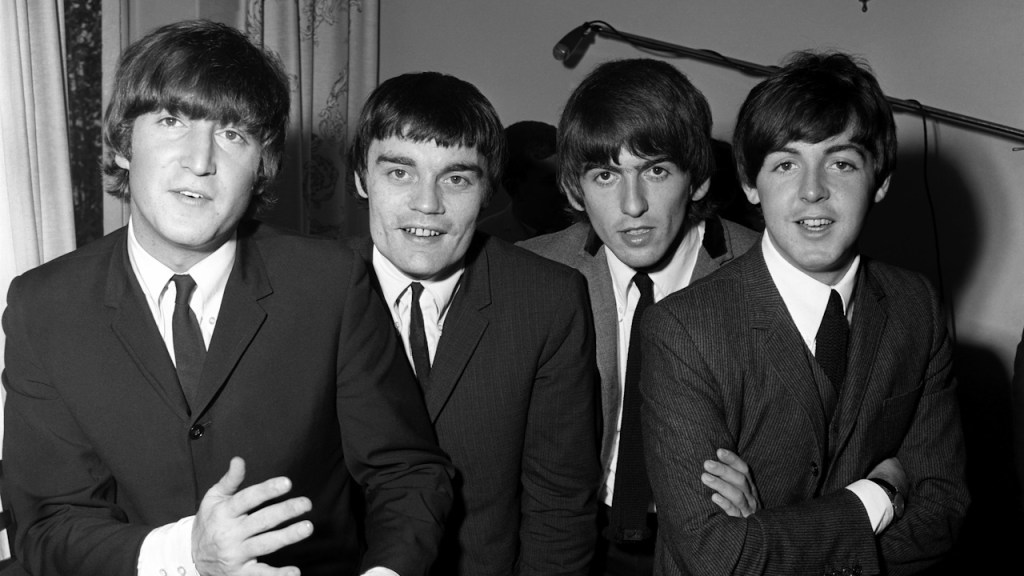
A New Book About The Beatles’ 1964 Australian Tour Is Coming
By David James Young
Australian publishing house Woodslane Press have announced a new book entitled When We Was Fab: Inside The Beatles ‘ Australasian Tour 1964 . As its title suggests, the book documents the first and only time that The Beatles ever came to Australia and New Zealand in June of 1964. Its release on Saturday, June 1st will fall on the eve of the tour’s 60th anniversary.
When We Was Fab was written by music historian Andy Neill and radio presenter Greg Armstrong. The former is a published author of biographies of The Who and Rod Stewart , having also published two Beatles photo anthologies. The latter, meanwhile, is the host of the Melbourne-based Let It Be Beatles , which is described as “the world’s longest-running weekly live radio show dedicated to The Beatles”.
The book is a comprehensive look at the tour, which saw 30,000 people line the streets of Adelaide to welcome the band to the city and Beatlemaniacs flooding the airport in Sydney and Melbourne upon their arrival. It compiles never-before-seen photographs, press clippings, interviews and eye witness recollections from over 100 people that either saw or participated in the band’s visit.
The Beatles – 1964 Australian Tour Highlight Reel
The tour was also notable for the partial absence of drummer Ringo Starr . Struck with tonsilitis before the start of the tour, he was replaced by unknown session drummer Jimmie Nicol for eight shows of the band’s world tour – including two performances in Adelaide. Starr officially rejoined his bandmates when they arrived in Melbourne, to perform at the city’s Festival Hall for six shows.
Although John Lennon never returned to Australia again prior to his death in 1980, the three remaining Beatles all returned. Paul McCartney toured Australia with Wings in 1975 and returned for a solo tour in 1993. He would not come back until 2017 , however, which was later followed by the Got Back stadium tour in October of last year.
Starr, meanwhile, would not return to Australia for 49 years after the 1964 shows. He eventually came back to Australia in 2013, performing shows with his All-Starr Band across the country. As for George Harrison , the dark-horse Beatle never toured Australia again but did have a holiday home on Hamilton Island known as Letsbeavenue. The home was built in the 80s, with Harrison visiting Australia for the final time in 2000 before his death the following year.
Pre-orders for When We Was Fab: Inside The Beatles’ Australasian Tour 1964 are on sale now via Woodslane Press .
Further Reading
Paul mccartney review – beatles, wings and a lifetime of memories in sydney.
Paul McCartney 2023 Australian ‘Got Back’ Tour Setlists
The Beatles Release Their Final Song ‘Now And Then’
Share article

A Guide to Every Australian Music Festival Happening in 2023/24
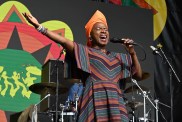
A Guide to Every International Tour Coming to Australia in 2023/24
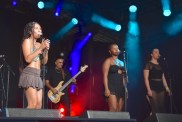
The Top 50 Australian Songs of 2023
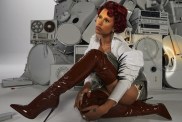
AJ Tracey, RAYE, Faye Webster + More Announce Laneway 2024 Sideshows
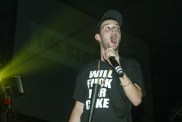
Golden Plains 2024: The Streets, Yussef Dayes, Cymande + More

WOMADelaide Announces 2024 Lineup: Gilberto Gil, Arooj Aftab, Yussef Dayes, WITCH + More

triple j’s Like A Version – The Complete List
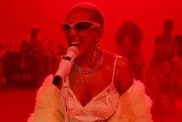
Triple J’s Hottest 100 of 2023: 100-1
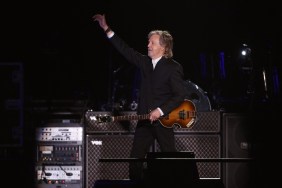
Paul McCartney 2023 Australian ‘Got Back’ Tour Setlists
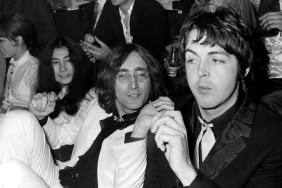
The Beatles Release Their Final Song ‘Now And Then’
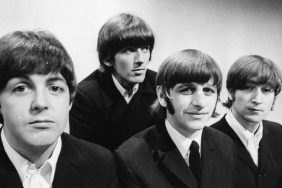
The Beatles Release Short Film Documenting the Making Of Their Final Song ‘Now and Then’
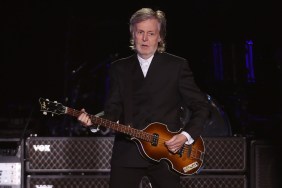
Anzac Day Public Holiday
Our Customer Service Centre, all Woollahra Libraries branches and the Woollahra Gallery at Redleaf will be closed on Anzac Day and reopen on Friday 26 April. Our after-hours call centre and emergency staff will still be available for urgent enquiries on 9391 7000, and you can log all customer service requests via the Woollahra App.

- Public Notices
- Integrated Planning and Reporting
- Budget and Financial Sustainability
- Find your Ward
- Councillors
- Role of Councillors and the Mayor
- Lobbying Councillors
- Expenses and Facilities Policy
- Chairmen and Mayors of Woollahra
- Members of Parliament
- Council Elections 2024
- Upcoming meetings calendar
- Agendas and Minutes
- Council meetings
- Planning panels
- Working parties and sub-committees
- Having your say at meetings
- Code of Meeting Practice
- Councillor Voting Register on planning matters
- Contact us online
- Getting to Council Chambers
- Make a claim
- Woollahra Council App
- Why work at Woollahra?
- Current Vacancies
- Recruitment and selection process
- Work experience and traineeships
- Frequently asked employment questions
- Equal Employment Opportunity (EEO)
- Workplace Health and Safety (WH&S)
- Child Safe Organisation
- Plans, policies and reports
- Council Resolution - 8-10 New McLean Street, Edgecliff
- Major Projects
- Minor works
- State Government Projects
- Community Engagement Projects
- Tenders, purchasing and expressions of interest (EOI)
- Register of Annual Disclosure of Pecuniary Interests
- Register of Council contracts
- Open Access Information not publicly available
- Donations and Sponsorship Register
- Public Safety CCTV in Double Bay Commercial Centre
- Data Breach Register
- Citizenship ceremonies
- Fees and charges
- Find your rubbish and scheduled clean up service dates
- Rubbish collection (red lid)
- Recycling collection (yellow lid)
- Organics collection (green lid)
- Additional collection services
- Scheduled clean-up service
- Disposal and re-use guide
- Recycle problem waste
- Skip bin providers
- Community initiatives and events
- Trade waste services
- Illegal dumping
- Private trees
- Public/Council owned trees
- Tree management for bushfire protection
- Trees and bats
- Trees and development work
- References, application forms and resources
- Resident Parking Permits
- Resident Visitor Parking Permits
- Responsible pet ownership
- Identification and registration
- Walking your dog
- Nuisance dogs
- Dog attacks
- Lost and found animals
- Choosing the purr-fect pet
- Dogs and kids safety
- Dead or injured animals
- Native animals and wildlife
- Stills photography
- Abandoned shopping trolleys
- Unattended and abandoned vehicles and items
- Graffiti removal
- Licensed premises - disturbance complaints
- Noise complaints
- Second-hand smoke
- Surveillance / security cameras, CCTV and drones
- Repairs and maintenance
- Infrastructure Asset Management
- Road opening permits
- Permit to stand plant
- Carry out works on public road including driveways
- Footway dining approval
- Parklet program
- Display of goods on footway
- Sale of Council land
- Leasing and licensing of Council controlled land
- Encroachments on Council road reserves
- Street lights
- The Bay Room
- Canonbury Cottage
- Cooper Park Community Hall
- Cross St, Studio 1
- The Cultural Hub
- The Studio at The Drill Hall
- EJ Ward Paddington Community Centre
- Rose Bay Cottage
- Sherbrooke Hall
- Vaucluse Bowling Club
- Grants & business support
- Business news & events
- Government tenders and procurement
- Starting a new business
- Woollahra economic data
- Sustainable business
- Contacts & resources
- Online payments
- Conveyancing certificates
- Change mailing address
- Street address numbering
- Road signs and linemarking
- Driveway linemarking
- Road closures, street parties and special events
- Works Zones (Construction Zones)
- Public transport
- Cycling and bike share
- Road Safety
- Coastal Inundation
- About building and development in Woollahra
- Contributions and VPA’s
- Environment and BASIX
- Exempt and complying development
- Heritage conservation
- Hierarchy of development rules
- Planning principles
- Requests for planning proposals
- Residential apartment development
- Object or comment on a DA
- Disclosure statements
- DA process overview
- Track or find a DA
- Prepare your application
- Avoid assessment delays
- Developments over $750,000
- Submitting 3D digital models
- Pre-DA consultation service
- Lodge your application
- About Development Applications
- Initial review
- Expert referrals
- Advertising and notification period
- Notification of DAs (Notice of proposed development)
- 3D modelling portal
- How are DAs determined
- Approved and refused DAs
- Register of exceptions to development standards
- Litigation protocol policy
- Construction certificates
- Principal certifiers and Council
- Builders - What you need to know
- Environmental protection tips
- Resolving complaints about building works
- Unauthorised building work and uses
- Asbestos Safety
- Fire Safety
- Private swimming pools and spas
- Window and balcony safety
- Library Catalogue/Login
- Book a Space
- Printing and photocopying
- Justice of the Peace service
- Library app
- Frequently Asked Questions (FAQs)
- Paddington Library - sparking curiosity for 130 years
- Discovering and Rediscovering Woollahra
- World War 1 Remembered
- World War 2 Remembered
- A brief history of Woollahra
- Council history
- External resources
- Family history
- Local areas
- Local history fast facts
- Oral history
- Searching your property
- Women in Woollahra
- Woollahra's historic landscapes
- Council records
- Digital Events
- eBooks and eAudiobooks
- eMagazines and eNewspapers
- Online information and databases
- Learn a language
- Advice for Readers
- Magazines and newspapers
- Community languages
- Library of Things
- Children's Services
- Youth Services
- Home Library Service
- Lifelong Learning
- Technology Help
- Events for Everyone
- Adult Workshops
- Talks and Conversations
- Writer Development
- Cultural Events
- Business Programming
- Technology Workshops
- Children 0-5 Years
- Children 5-12 years
- School Holidays
- Youth events
- Events for Seniors
Nominate a person or event
- Alan Falconer Kippax
- Alan Stuart Morris
- Bombardment 1942
- Captain John Piper
- Captain William John Dumaresq
- Christina Stead
- Dame Joan Sutherland OM AC DBE
- Dr Elwyn Lynn AM
- Dr Max Herz
- Edward Knox Harkness and Walter Scott Harkness
- Edward Albert 'Douglas' Watson
- Eleanor (Nellie) Stewart
- Elizabeth Macarthur
- First Seaplane flight over Sydney
- Frederic Lassetter
- Herbert Henry (Dally) Messenger
- James Francis (Frank) Hurley
- Jeff Freeman
- Jessie, Lady Street
- John Fairfax
- John Peter Russell
- Margaret Olley AC
- Michael Guilfoyle
- Montague Alfred (Monty) Noble
- Sir Percival Halse Rogers
- Peter Sculthorpe
- Robert Cornelius Joyner
- Rudy Komon MBE
- Shay Docking
- Sir Daniel Cooper
- Sir John Hay
- Sir John Robertson
- Sir Alexander MacCormick KCMG
The Beatles Concerts at the Sydney Stadium, June 1964
- Thomas Sutcliffe Mort
- William Warrell
- Wintergarden Theatre
- World Heavyweight Boxing Championship Title Fight 1908
- Karoo - Cora Gooseberry
- Sir Mark Sheldon KBE
- James (Jim) Charles Bancks 1889 - 1952
- Sir Mungo William MacCallum KCMG 1854 - 1942
- Gisella Scheinberg OAM
- Newsletters
- Produce an Event
- Conditions of Entry
- Digital Literary Awards - Frequently Asked Questions
- Past winners of the Woollahra Digital Literary Award
- 2023 Digital Literary Awards Ceremony
- Children and families
- Disability Inclusion
- Domestic, Family & Sexual Violence
- Homelessness
- Mental health and suicide prevention
- New residents
- #RacismNotWelcome
- Art Gallery
- Author Talks
- Woollahra Creative Hoardings Program
- Digital Art and Culture
- Library artwork commissions
- Pop Up Posters Paddington
- Reconciliation
- Tell your story - local voices
- Up the Wall Mural Project
- Walking Tours - DIY Arts and Culture
- Woollahra Small Sculpture Prize
- Youth Photographic Award & Short Film Prize
- Bush Tucker Walks
- Festival of Fun New Experiences
- NAIDOC Week
- International Women's Day
- Woollahra Garden Awards
- Community engagement
- Hall and venue hire
- Hire a park
- Hire a sports ground
- Strategic plans
- Jumpstart Program
- Resources and toolkits
- Community plans, studies and liaison groups
- History and heritage
- Population and economic profile
- Our approach to community building
- Accessibility
- Our climate change action
- Switch to GreenPower
- Go electric
- Solar Panels and Your Home
- Solar My Suburb
- Apartment and Strata Energy Savings
- Keeping cool this summer
- Our water quality projects
- Harbour water quality
- Save water at home
- Report water pollution
- Floodplain management
- Water restrictions
- Our water saving projects
- Threatened Species
- Native gardening
- Weeds and Invasive Species
- Bushcare volunteering
- Report a wildlife sighting
- Stories of local biodiversity
- Walk a nature trail
- National Tree Day
- Our bushland projects
- Upcoming events
- Environmental Grants
- Sustainable schools
- HarbourCare
- Get involved
- Our Action Plan
- Electric vehicle charging stations
- Walks in Woollahra
- Get Involved
- Our Projects
- Water craft storage
- Location of dinghy storage facilities
- Dinghy storage hire waiting list
- Community gardens
- Exercise equipment in parks
- Commercial fitness training
- Marquees and amusement devices
- School picnics
- FAQs for social events park hire
- Harbourside pools and baths
- Smoke free zones in Woollahra
- Sports ground closures and wet weather
- Seasonal hirers
- Tennis courts
- Gap Park Historic Tramway Trail
- Art and Culture Walks
- Bondi To Manly Walk
- Harbour Walk - Rushcutters Bay to Rose Bay
- Harbour Walk - Rose Bay to Watsons Bay
- Coast Walk - Christison Park to Inner South Head
- Other venues in Woollahra
- FAQs for weddings and ceremonies park hire
- Open Space & Recreation Strategies and Plans Of Management
- Latest news
- Council newsletters
- Media contacts
- Have Your Say
- What's On Woollahra Booklet
- Planning and promoting an event
- Annual event calendar 2024

Plaque location
Plaque unveiling, the beatles concerts at the sydney stadium 18-20 june 1964, the fab four, the sydney stadium, 'the old tin shed', corner new south head road and neild avenue.
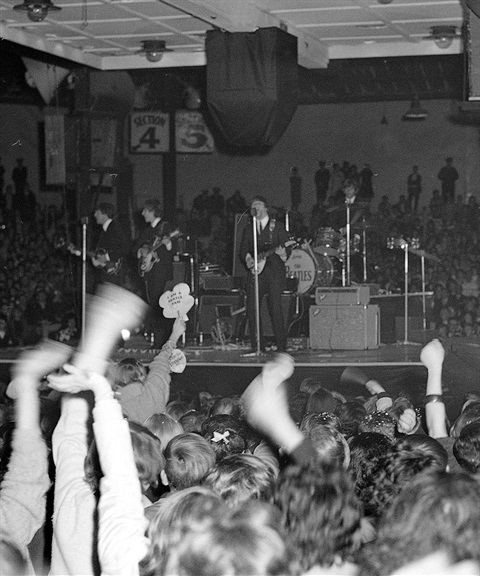
Between 18-20 June 1964, ‘Beatlemania’ arrived in Sydney. The Beatles performed six concerts at the Sydney Stadium, Rushcutters Bay as part of a two week tour of Australia and New Zealand. The tour was a major event for Australia - a link to the international culture of the 1960s, and a ‘once in a lifetime celebration of youthful rebellion’ for thousands of Sydneysiders.
Corner of Neild Avenue and New South Head Road, Paddington
View all plaques in Paddington
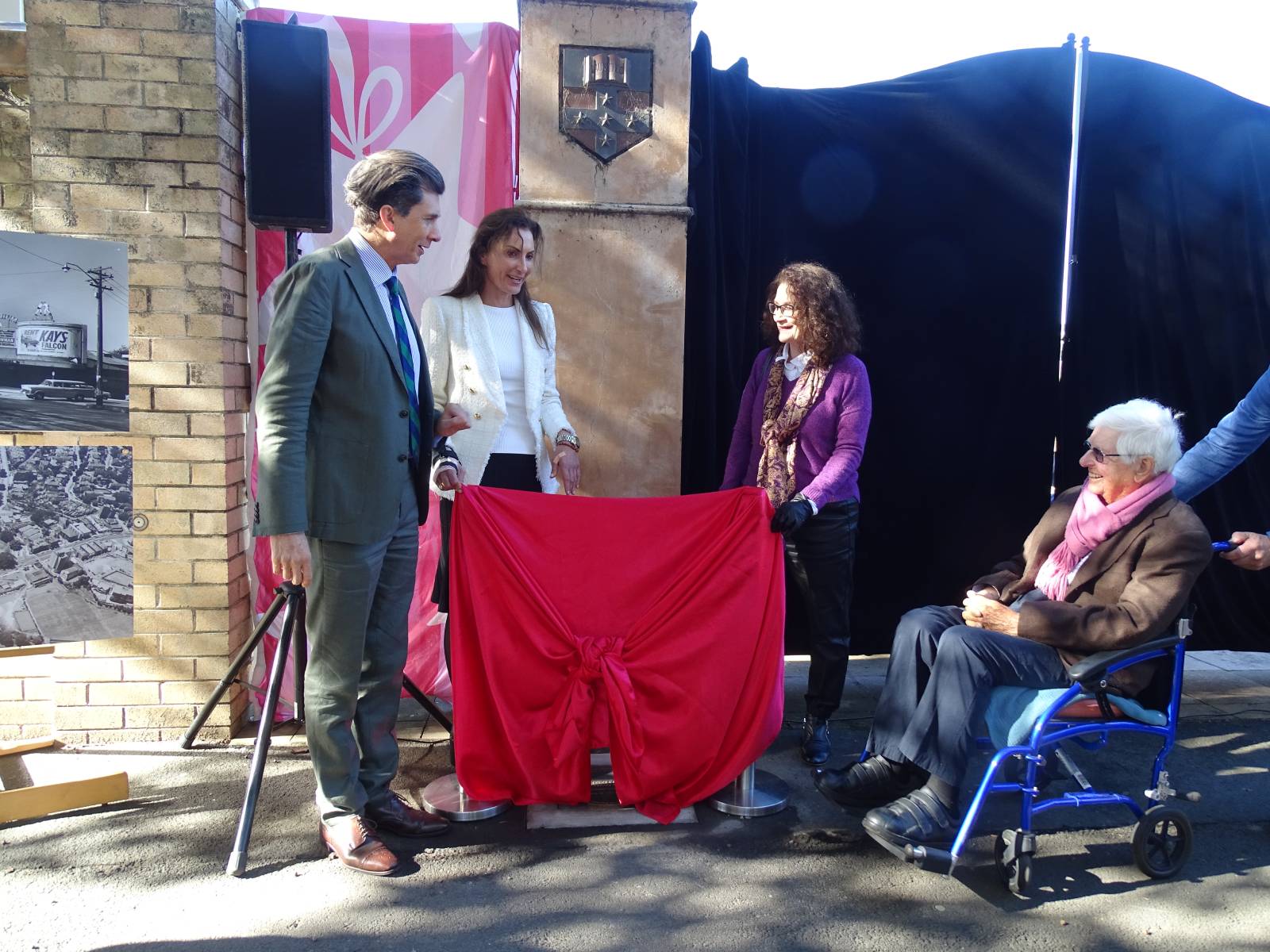
Plaque unveiling for The Beatles Concerts at the Sydney Stadium in June 1964. L-R Cr Anthony Marano, Mayor of Woollahra Cr Susan Wynne, guest speaker Dr Janis Lander, guest Bob Rogers OAM.
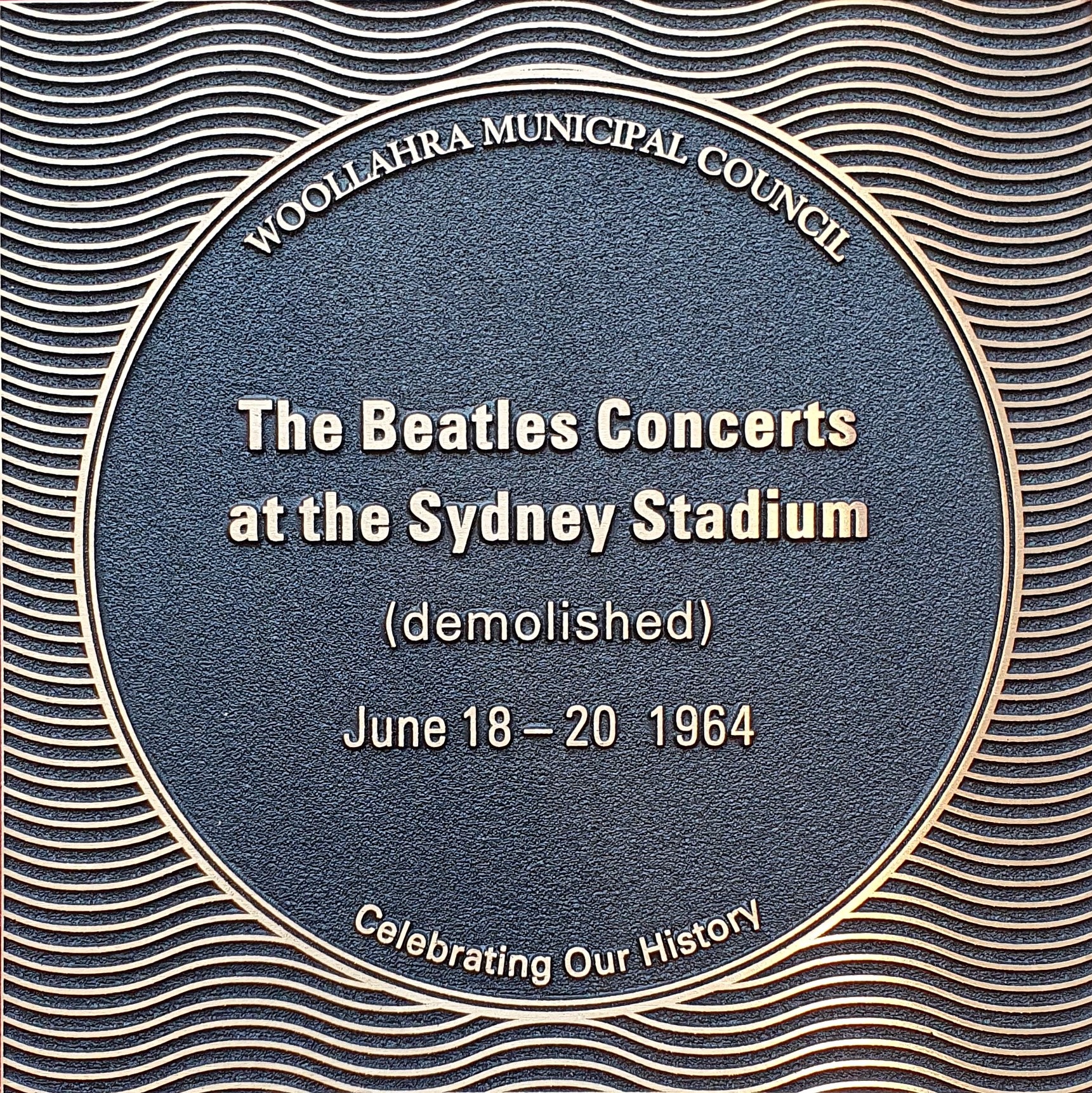
On 16 June 2021, a plaque commemorating The Beatles 1964 concerts in Sydney was unveiled near the site of the Sydney Stadium (demolished), the venue for the concerts on 18-20 June 1964.
The plaque is located on the footpath on Neild Avenue, near the corner of New South Head Road, Rushcutters Bay.
Watch the plaque unveiling here
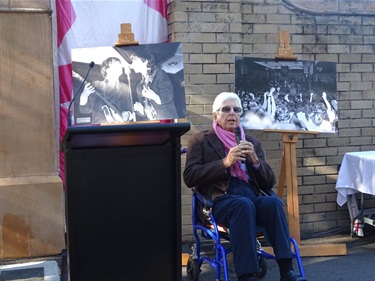
DJ and radio broadcaster Bob Rogers OAM, who toured with the Beatles in 1964, speaking at the event
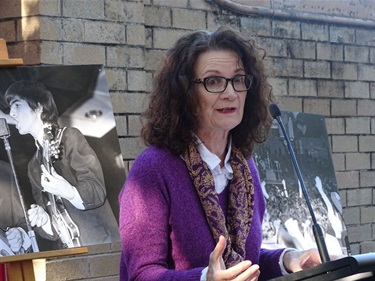
Guest speaker Dr Janis Lander
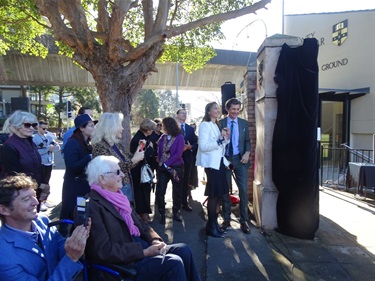
Guests at the plaque unveiling for The Beatles Concerts at the Sydney Stadium in June 1964
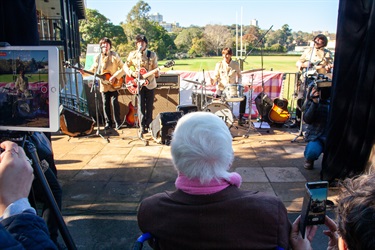
Guests watching the Beatles tribute band 'Beatle Magic'
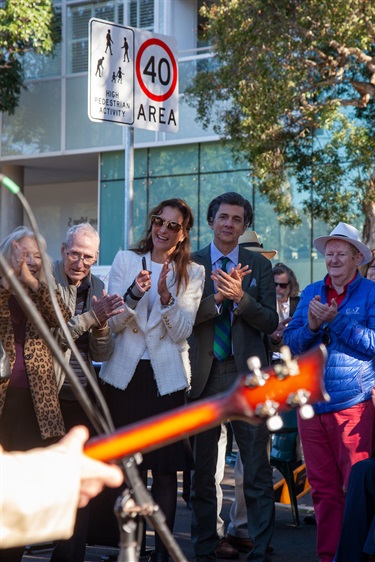
Guests with Mayor of Woollahra Cr Susan Wynne (centre), Cr Anthony Marano and Cr Peter Kavanagh
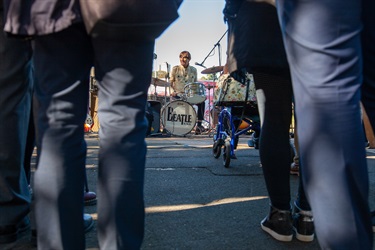
Tribute Band 'Beatle Magic' playing at the event
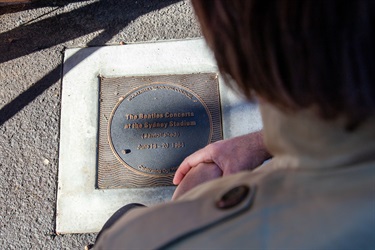
Plaque unveiling for The Beatles Concerts at the Sydney Stadium
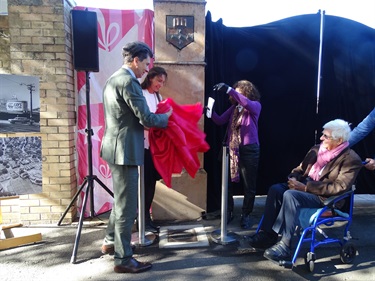
L-R Cr Anthony Marano, Mayor of Woollahra Cr Susan Wynne, guest speaker Dr Janis Lander, guest Bob Rogers OAM
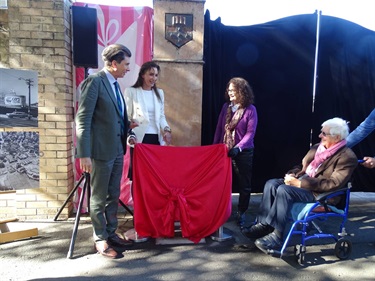
Guest Sheridan Rogers
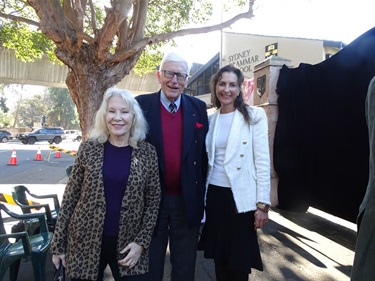
Guests with Mayor of Woollahra Cr. Susan Wynne
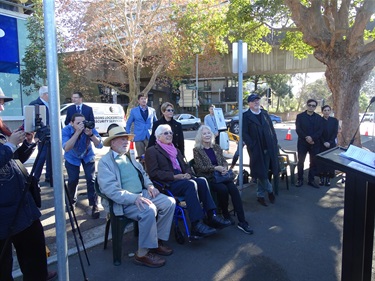
Guests at the plaque unveiling
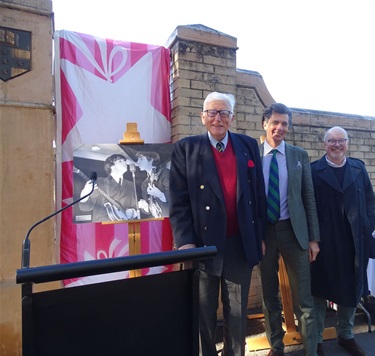
L-R Chris Dawson, Cr. Anthony Marano, Graham Humphrey
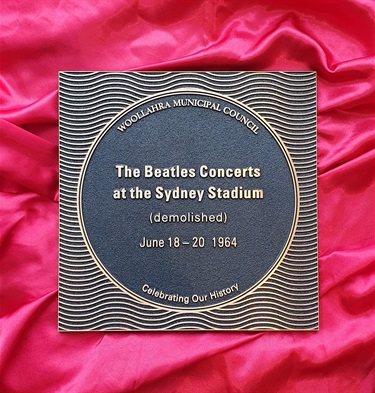
Plaque for The Beatles Concerts at the Sydney Stadium in June 1964
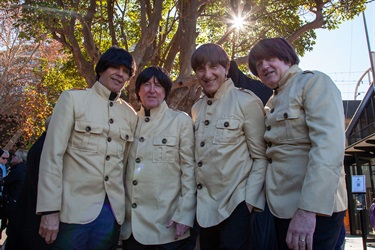
Tribute band 'Beatle Magic' who performed at the event
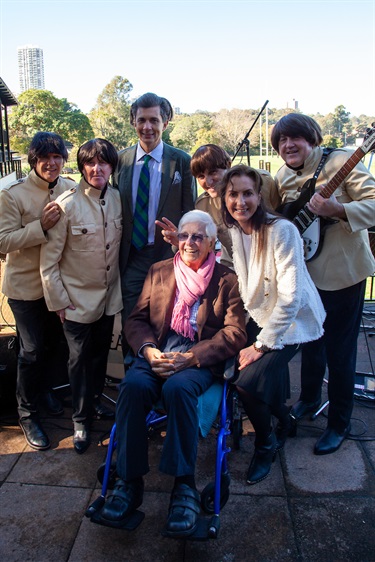
Members of the band 'Beatle Magic' with Cr Anthony Marano, Mayor of Woollahra Cr Susan Wynne and Bob Rogers OAM (centre)
In June 1964, 'Beatlemania’ arrived in Sydney. The Beatles performed six concerts at the Sydney Stadium i , Rushcutters Bay as part of a two week tour of Australia and New Zealand.
For all the charisma the four emitted, the real stars of the tour were the hundreds of thousands of ordinary people who screamed in public and viewed in private who were caught up by accident or intent in the joyful madness that swept the land... Glenn A. Baker, The Beatles down under : the 1964 Australia and New Zealand tour , p. 7
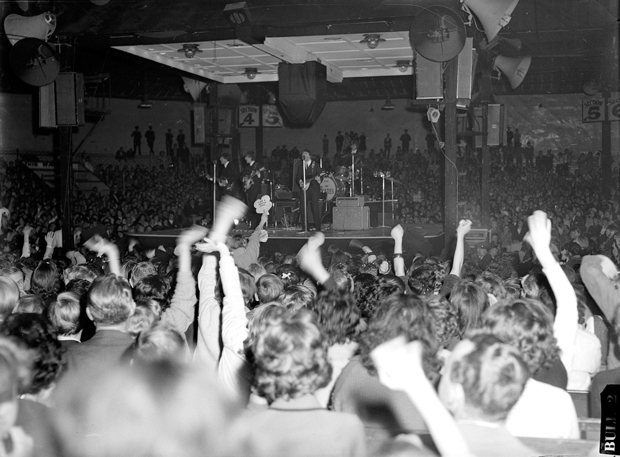
‘Beatlemania’
In 1963, the British Press coined the term ‘Beatlemania’, describing
the relentless and seemingly hysterical response of that country’s teenagers to an indeterminate mixture of musical presence, public personality, and social significance that was projected by this pop group from the port city of Liverpool, whose fresh-faced exuberance and insouciant wit had endeared them to a substantial number of adult Britons as well Jonathan Gould, Can't buy me love: the Beatles, Britain, and America , p. 1
The first Beatles single to be released in Australia was Please Please Me , issued on February 21, 1963 by EMI Records. The song was the second UK chart hit for the Beatles, making No. 2, but did not have the same success in Australia, the Beatles having been treated with a degree of indifference by the ‘painfully conservative Australian media and entertainment industry’. ii
This all changed in 1964, ‘the year that the 'Fab Four' took their potent aura to the world’. iii By then, the Beatles had notched up three UK No. 1 hits - From Me to You , She Loves You and I Want to Hold Your Hand .
In February 1964 a Pan American Airways jetliner at Kennedy Airport delivered the group to New York, beginning the Beatles' so-called ‘conquest’ of America, with a tour of the East Coast. They appeared twice on the Ed Sullivan Show, performing at the Washington Coliseum and Carnegie Hall in New York. Capitol Records had spent $50,000 promoting the group.
Filming for the movie A Hard Days Night began in the UK just 9 days after the Beatles return from the US. By this time, seven of Australia’s ‘top 40’ records were Beatles numbers - She Loves You stayed on the Australian charts for 42 weeks.
In June 1964, following a series of concerts in Holland and Denmark, the Beatles undertook a ‘Far Eastern Tour’, flying first to Hong Kong, ahead of two weeks of engagements in Australia and New Zealand.
Australia – 1964
"It all started on June 11 with a scheduled flight from Hong Kong’s Kai Tak that refuelled in Darwin where Australia witnessed the first manifestation of Beatlemania; at 2.35 on a winter’s morning 400 fans crowded the little terminal to see John Lennon, Paul McCartney, George Harrison and stand-in drummer Jimmy Nicol pass through Customs and Immigration". iv
‘Beatlemania’ had arrived ‘down under’ - it was the only time the Beatles would tour Australia. Author Jonathan Gould commented that "of all the tumultuous public receptions the group would experience, nothing before or after, in terms of scale, would compare with what awaited them in Australia". v
Incoming passenger cards record the arrival of the Beatles in Darwin on 11 June 1964, on BOAC Flight 801, listing their occupations as ‘Musician’ and length of stay 10 days. vi The Beatles’ onward flight touched down at Sydney’s Mascot airport just before 7:45am on Thursday 11 June 1964. Australian television, which was just eight years old, broadcast the event live to hundreds of thousands of viewers who watched the Beatles being ferried to the terminal on the back of a truck, in wind and drenching rain. vii
While in Sydney, The Beatles stayed at the Sheraton Hotel, Potts Point (40 Macleay Street, now apartments), taking over the top floor. The New York City Police department had given a warning to Australia, advising that ‘there will be chaos and confusion’ wherever the Beatles go. Hong Kong’s police chief had confidentially advised Sydney CIB that supporters (particularly young girls) would besiege their hotels, but that the Beatles themselves were amiable, and would ‘co-operate with police in the preservation of law and order’, spending most of the time, when not performing, in their hotel suites. viii
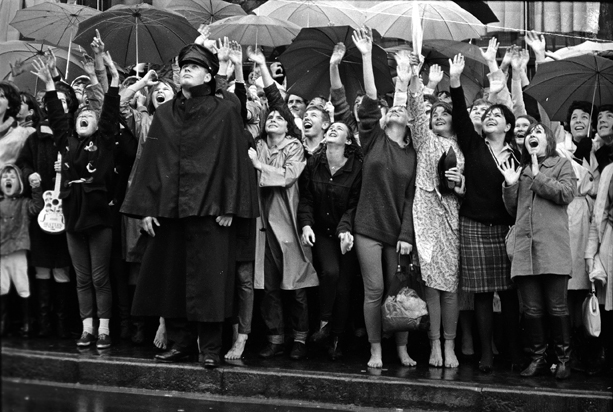
The Beatles' tour caused consternation among Australian police, aviation officials, hotel owners, parents and schools. Four of Sydney’s leading hotels (the Menzies, Chevron, Hotel Australia and Town House) had refused to book the Beatles. Eventually the owner of the small Sheraton Hotel in Macleay Street, Potts Point, offered to have them – it was a decision that would provide the hotel with free publicity for years to come. The Chevron manager wryly noted that they had originally refused the booking because of the expected crowds inside and outside the hotel - they got them anyway, but without the money or publicity, fans taking up vantage points outside the Chevron, hoping for a glimpse of the Beatles in the Sheraton Hotel opposite.
A polarisation of opinion regarding the presence of the Beatles was made obvious in the reaction of two Sydney girls schools. Miss P. Evans, headmistress of Ravenswood Methodist School banned students from having Beatles haircuts or carrying photos, stating that ‘We don’t want Ravenswood to be involved with those screaming mobs. I want to safeguard these children from something they do not understand’. On the other hand, Miss Betty Archdale, the indomitable principal of Abbotsleigh School for Girls at Wahroonga took a more enlightened view, allowing the girls to pin photos of the Beatles on their dormitory walls, and to watch the Beatles on TV, saying ‘I see no harm in the Beatles or the craze they have started’. ix
The first of the Beatles' twenty Australian shows was in Adelaide, followed by Melbourne, Sydney and finally Brisbane. The concerts usually consisted of a ten-song, half-hour set, performed to screaming audiences and padded out by four support acts. The show was compered by Alan Field, with performances in the first half by The Phantoms, who stayed on to back Johnny Devlin and Johnny Chester – the first half closed with Sounds Incorporated and the Beatles played the whole of the second half. There were two shows each night, one at 6pm and one at 8pm, and none on Sundays. Between the Sydney and Brisbane concerts there was an eight-day tour of New Zealand. x
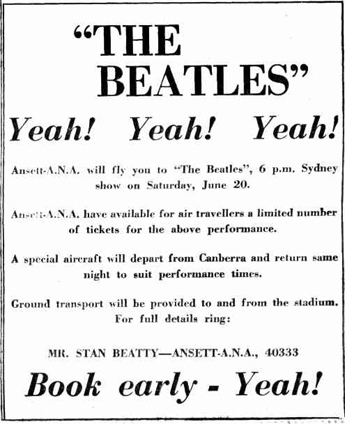
“No single instance of Beatlemania throughout the globe ever came close to the intensity and sheer magnitude of the social upheaval which accompanied the 1964 Australian Beatles’ tour” Glenn A. Baker, The Beatles down under , p. 7
The concerts - Sydney Stadium
Between 18-20 June 1964, The Beatles performed six concerts at the Sydney Stadium, Rushcutters Bay. Ticket prices ranged from 15s 6d to £1 17s 6d. xi
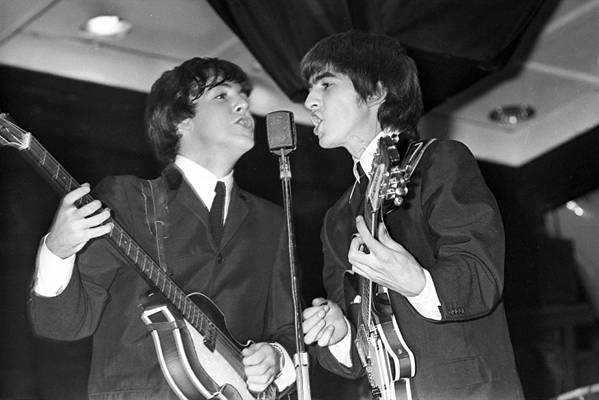
Unlike the reception in Adelaide, where a large portion of the population had turned out, the initial response when the Beatles returned to Sydney was muted, with a relatively quiet crowd at the airport. Melbourne too had seen fairly chaotic scenes, with the Victorian police calling in the army and navy to assist.
The Beatles had by this time been reunited with their drummer, Ringo Starr, who had missed the first part of the tour due to a bad bout of tonsillitis, re-joining the Beatles in Melbourne. Stand-in drummer Jimmy Nicol quietly left Australia before the group returned to Sydney.
The first two Sydney concerts, on Thursday 18 June 1964, were only three quarters full. Promoter Kenn Brodziak was reported as saying “To this day, I’m not really sure why this happened. I tend to think that the sort of hysterical coverage which the Sydney press liked to run, frightened a lot of parents who thought there would be some kind of wild riot”. Following the first shows, when it was clear that no one would be trampled to death, the remaining four shows were packed. xii
A three minute newsreel in the National Film and Sound Archive (NFSA) features live footage of The Beatles and their fans during a concert in Sydney during their 1964 tour of Australia: The Beatles at Sydney Stadium, 1964 . The curator notes that ‘Concert footage of popular acts was still in its infancy in the 1960s’ and ‘This professionally shot footage is the result of employing multiple cameras and stylish editing in post-production that effectively captures the phenomenon known as 'Beatlemania'’.
Terry Smith, Sports Journalist, devotes a chapter to ‘Beatlemania’ in his book The old tin shed , a history of the Sydney Stadium. He attended the first Beatles concert in Sydney - tickets being one of the perks of being the Sydney Morning Herald ’s boxing writer:
‘None of us who packed into the Stadium for the first Sydney concert…will ever forget it. Onto the revolving stage trotted The Beatles through a phalanx of uniformed police and security men’…‘It was absolute bedlam. The screams hit the tin roof and echoed round the stadium to create a noise level claimed by a sound expert to exceed that of a Boeing 707 jet in full flight’.
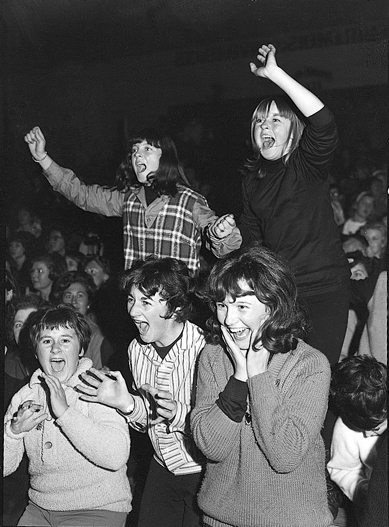
Annette Dixon, who was thirteen years old when she attended one of the concerts at the Sydney Stadium in 1964, shared her reminisences of the event:
I saw The Beatles then [in 1964]. My mum saved money to buy my ticket and our neighbour did the same for their daughter Sandra Hanmer. Her elder sister took us. We sat in what was called “the bleachers” … we screamed with everyone else - then we followed the crowd up to their [The Beatles] hotel Sheraton. They came out onto the roof of their hotel and threw a bucket of water out into the crowd. We gladly got wet. So, so long ago for us two 13 year olds. Annette Dixon
Newspaper reports of the Sydney concerts ranged ‘from the puerile to the refreshingly serious’. xiii Craig McGregor, of the Sydney Morning Herald , gave the ‘sole serious appraisal of the performance’ writing:
“The Beatles showed themselves last night to be every bit as polished, as exciting and engaging in person as they are on records – and what is more surprising a great deal gentler. This quality is somewhat unexpected in a Liverpool beat band whose music is raucous R&B, only slightly mellowed by a native English interest in harmony and musical colour …It was unexpected to find them singing numbers like ‘All My Loving’ and ‘I Saw Her Standing There’ with such warmth and romanticism…Yet the Beatles were, without a doubt the wildest, swingiest and ravingest quartet of pop musicians to hit the stadium since Little Richard.”
Most other reporters focused on the noise and hysteria of the fans. Ron Ford, of the Sun , had reported:
“It hit the tin roof of the Stadium and thundered round the empty bleachers: She was Just Sev! En! Teen!. The first real live Beatle sound in Sydney. And that’s all they got out before the shrieks took over for thirty minutes solid. It was hard to believe that these four frail and largely lifeless looking lads could whip up such a scene. Round and round went the baffled Beatles [ a reference to the Stadium’s revolving stage ] with a ‘stop the stage I want to get off’ look on their faces.”
After the final two concerts the Sunday Telegraph reported that “Screaming teenagers last night turned the Beatles’ last two concerts into near riot” and the Sun-Herald noted that “Thousands of girls under sixteen who occupied the most expensive seats seem to be in a state of delirium …”
All three Sunday newspapers carried extensive reviews of the fifth and sixth concerts on Saturday night – the first to have ‘house-full’ signs up before the headliners hit the stage. The late show was the balltearer of the tour and even the out of touch reviewers managed to realise it .. Glenn A. Baker, The Beatles down under , p. 101
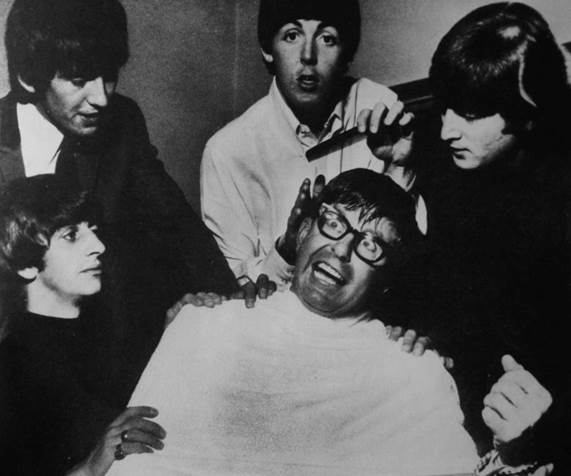
“From the beginning there were several attributes that distinguished the Beatles from anything that had happened in popular music before. The first was their nationality. Since the term had been first coined in the 1920s, the very concept of a ‘superstar’ had become synonymous with celebrity entertainment culture of the US. The Beatles in 1964 were the first unmistakably non-American performers to achieve the status of superstars on an international scale ..spearheading a British invasion of the American music scene. Jonathan Gould, Can't buy me love , p. 9
The Beatles grew up in Liverpool, one of the British seaports serving North America, which picked up the new rhythm and blues releases from sailors before the rest of Britain caught on.
In all but name, the Beatles began with the friendship of John Lennon and Paul McCartney who met in July 1957 at a garden fete at St Peter’s Church, Woolton. xiv John Lennon’s band, the Quarrymen, played a mix of rock & roll and skiffle, which had jazz, blues and folk influences. Shortly afterwards Paul McCartney joined the band as rhythm guitarist. By the summer of 1958, the nucleus of the future Beatles, - Lennon, McCartney and Harrison – was formed …not so much a band as a small circle of musical friends xv , including John’s friend Stuart Sutcliffe. They adopted the name the Beatles in August 1960, recruiting drummer Pete Best before a series of engagements in Hamburg. Stuart Sutcliffe left the Beatles in 1961 to pursue a career in art and Ringo Starr replaced Pete Best in August 1962, completing the line-up most usually associated with the Beatles – John, Paul, George and Ringo.
In November 1961, Brian Epstein heard the Beatles play at the Cavern Club in Liverpool, and was immediately taken with them. Over the next few months he courted the group, becoming their manager in 1962.
“The years of [the Beatles] story coincided with a period of rampant social and cultural change in Britain and America, and throughout the industrialised world” … ‘it culminated during the 1960s with the emergence of London as a world capital of pop culture, ruled by an unruly elite of ‘war babies’ who were bent on taking their country’s new climate of expressive freedom to once unimaginable extremes. The Beatles began as creatures of this new social and cultural milieu; they wound up serving as the most prominent symbols of it for people all over the world”. Jonathan Gould, Can't buy me love , p. 14
In 1965 the British Prime Minister’s office, under newly elected Douglas Wilson, a fellow northerner, announced that the Beatles were to be appointed as Member of the Order of the British Empire (MBE). Surprisingly, the award cited their contribution to commerce, not the arts, with some estimates putting the Beatles records sales at more than 150 million records worldwide by August 1965 xvi . A growth in Britain’s fashion, entertainment and tourism industries was also attributed to a rising ‘pop Anglophilia’ in the US, Europe and Asia.
The Beatles were inducted into the Rock and Roll Hall of Fame in 1988 by Mick Jagger. xvii
John Winston Lennon MBE - 9 October 1940 – 8 December 1980
John Winston Lennon gained worldwide recognition as the founder, co-lead vocalist, and rhythm guitarist for the Beatles - his songwriting partnership with fellow Beatle Paul McCartney recognized as one of the most successful in the industry.
In 1969, he started the Plastic Ono Band with his second wife, Yoko Ono. After the Beatles disbanded in 1970, Lennon continued with a solo career releasing the album Imagine . ‘Following the release of Imagine , Lennon’s nonmusical activities and personal life tended to overshadow his career as a recording artist’ - John Lennon and Yoko Ono moved to New York city in 1971 where they ‘immersed themselves in various left-wing political causes’ xviii , and were critical of US involvement in the Vietnam War, creating issues with John’s residency visa in 1973. Following the birth of his son Sean in 1975, John Lennon withdrew from the public and devoted the rest of the 1970s to his family.
Along with the other Beatles, John Lennon was appointed a Member of the Order of the British Empire (MBE) in 1965, but returned his medal in November 1969, with an accompanying letter stating: ‘I am returning this MBE in protest against Britain's involvement in the Nigeria-Biafra thing, against our support of America in Vietnam and against Cold Turkey slipping down the charts.’
John Lennon was tragically shot and killed outside his Manhattan apartment building in 1980 by a Beatles fan. He was inducted into the Rock and Roll Hall of Fame (posthumously) as member of the Beatles in 1988, and as a solo artist in 1994.
Paul McCartney (Sir James Paul McCartney CH MBE) 18 June 1942 -
Paul McCartney gained his initial international fame as co-lead vocalist and bass guitar player for the Beatles. Born in Liverpool, he attended the Liverpool Institute High School (a grammar school), where he befriended George Harrison. Paul McCartney’s songwriting partnership with John Lennon produced a large portion of the Beatles catalogue – both wrote lyrics as well as music – but many other well-known hits are credited to Paul McCartney, including: And I Love Her (1964), Yesterday (1965), Eleanor Rigby (1966) and Blackbird (1968). After the Beatles disbanded in 1970, Paul McCartney pursued a solo career, forming the band Wings with his first wife, Linda, and Denny Laine (formerly of the Moody Blues) – the group achieved a number of hit singles and albums during the 1970s – including Mull of Kintyre , a record selling single released in 1977. Since the 1980s he has toured and performed as a solo artist. Paul McCartney’s interests beyond music include a commitment to a number of international causes and charities including animal rights and vegetarianism.
In an essay for the Rock and Roll Hall of Fame - Paul McCartney was inducted as a solo artist in 1999 – teacher, journalist and music critic for the New York Times , Allan Kozinn, says of Paul McCartney:
“The fact is, his salient feature as an artist is not, as some might assert, the ability to spin out a melody at the drop of a hat. What really drives him, as both composer and performer, is an unquenchable musical curiosity and the urge to constantly create.’ ‘He could, of course, leave the public stage secure in the knowledge that his existing work will continue to thrill people in great numbers, and with his place in musical history assured many times over. But for someone with McCartney’s creativity and drive, stopping would be incomprehensibly out of character” . xix
Paul McCartney received a knighthood in 1997 for services to music in the British and in the 2018 Queen’s Birthday Honours list he was awarded a Companion of Honour (CH) for his ‘lasting contribution to music in the UK and Worldwide’ xx .
George Harrison MBE 25 February 1943 - 29 November 2001
George Harrison was born on 25 February 1943 in the family home in Wavertree, Liverpool. He joined the Beatles in 1958, and was only 17 when the group went to Hamburg in 1960, achieving international fame as the lead guitarist for the Beatles. By 1965 George Harrison had developed an interest in folk rock, including the music of Bob Dylan and the Byrds, and Indian Classical music – these influences can be found in some of the Beatles later work such as Norwegian Wood , in which he used the sitar. Although the majority of the band’s songs were Lennon- McCartney compositions, George Harrison was also a songwriter – his work included well known Beatles songs such as While My Guitar Gently Weeps and Here Comes the Sun.
After the band broke up in 1970, Harrison released a triple album All Things Must Pass , which contained the hit single My Sweet Lord. He also organised a 1971 Concert for Bangladesh with Indian musician Ravi Shankar, and founded Dark Horse Records in 1974. George Harrison continued to perform as a guest guitarist and collaborated with Bob Dylan, Eric Clapton, Ringo Starr and others.
George was a Rock and Roll Hall of Fame inductee in 2004 (posthumously) for his solo career. When George Harrison died from lung cancer in 2001 at the age of 58, his remains were cremated and the ashes were scattered according to Hindu tradition in a private ceremony in India.
Ringo Starr (Sir Richard Starkey MBE) 7 July 1940 -
Best known as the Beatles’ drummer, Ringo Starr, Richard Starkey was born in Liverpool in July 1940, growing up in a run-down working class area of the city known as Dingle. Despite a childhood beset by medical issues, which impacted his education, Ringo ‘had decided flair’ - he was the ‘master of the Liverpudlian deadpan, the slow Liverpudlian double-take, and the curt Liverpudlian retort’ - and ‘from the moment he joined, the Beatles became almost unimaginable without him’ xxi . He sang vocals on a number of well-known songs, including Yellow Submarine and With a Little Help from My Friends , and wrote or co-wrote others, including Octopuses Garden .
Prior to joining the Beatles, Ringo co-founded the Eddie Clayton Skiffle Group (1957), later joining Rory Storm and the Hurricanes which became a popular Merseyside band. He left the Hurricanes when he was asked to join the Beatles in August 1962. Ringo has had a successful career in music and film following the Beatles break up, narrating the first two series of the children's television programme Thomas & Friends, also touring with Ringo Starr & His All-Starr Band.
In the testimonial on the Classic Drummer Hall of Fame, Ringo is said to have been the inspiration for many professional drummers.
"More than any other drummer, Ringo Starr changed my life. The impact and memory of that band on Ed Sullivan Show in 1964 will never leave me. I can still see Ringo in the back moving that beat with his whole body, his right hand swinging off his sock cymbal while his left hand pounds the snare. He was fantastic, but I think what got to me the most was his smile. I knew he was having the time of his life." Max Weinberg xxii
Ringo was inducted into the Rock and Roll Hall of Fame as a solo artist (2015) xxiii and was appointed a Knight Bachelor for services to music in the 2018 UK New Year Honours List. xxiv
The promoter - Kenn (Kenneth Leo) Brodziak 31 May 1913 – 3 June 1999
“Kenn Brodziak’s presentation of the Fab Four from Liverpool, still cited as the greatest entertainment coup Australia has ever witnessed, was not the result of great vision or adept negotiation. It was, in fact, a classic piece of accidental good luck”. Glenn A. Baker, The Beatles Down Under
The Beatles tour was booked in July 1963 by Australian promoter Kenn Brodziak, Managing Director of Aztec Services Pty, who co-promoted international acts with Richard (Dick) Lean, Managing Director of Stadiums Ltd, managers of the Sydney Stadium. Brodziak had booked the Beatles - well before ‘Beatlemania’ became a worldwide phenomenon - as a supporting act for the modest sum of £1000 a week (accommodation not included) xxv . It was a verbal contract, not finalised until January 1964 when Epstein, the Beatles manager, honoured the original agreement to tour Australia, albeit asking for a slight increase to £1500 per week – it was still well short of the going rate. According to Glenn A. Baker, ‘at ten times that it would still have been an outrageous steal’.
“The Australian promoter, Kenn Brodziak, had negotiated the tour in July 1963, before the hysteria had begun in England. By the time they arrived here, they were the biggest musical act on the planet and Brodziak had his hands on the most successful undertaking in Australian show business history. In the intervening 11 months, the English press had coined the word ‘Beatlemania’ to describe the frenzied screaming of fans. This phenomenon had created a huge international demand for records, merchandise and concert tickets”. Peter Cox, The Beatles in Australia Essay , MAAS, 5 April 2018
Sponsors negotiated for the tour included the British Motor Company, who provided Austin Princess and Morris 1100 cars for the entourage, and Ansett, who outbid TAA by providing air transport for free. xxvi TAA did however manage to create some publicity of their own - the Beatles had arrived in Sydney in the middle of a storm, and agreed to tour the fans enclosure in an open truck despite the weather. As the group disembarked the aircraft, a quick thinking TAA executive handed each of them a large umbrella, boldly marked with TAA lettering, and the iconic images of the Beatles in their capes and TAA umbrellas went round the world.
Brodziak was an influential figure in the history of promotion in Australia, bringing the stage show Godspell to Australia, as well as touring Cliff Richard and the Shadows, Bob Dylan, Marlene Dietrich, The Vienna Boy’s Choir, and Peter Paul and Mary, amongst others.
The Sydney Stadium was initially conceived as a temporary structure, constructed by promoter Hugh D. McIntosh for the World Heavyweight Boxing title fight between Canadian Tommy Burns and Australian Bill Squires in August 1908. In December of the same year, the Stadium was the setting for another World Heavyweight title bout, when challenger Jack Johnson defeated Tommy Burns becoming the first African-American to win the title. xxvii
In 1912 the Sydney Stadium was roofed over and enlarged to a design by architect T. P. Sampson xxviii , becoming a more permanent structure, albeit of wood and galvanised iron, affectionately known as the 'old tin shed'. The roof was built in the form of an octagon and it was to become an iconic Sydney boxing and entertainment venue, hosting numerous boxing bouts and playing host to The Beatles, Louis Armstrong, Frank Sinatra, Buddy Holly, and The Rolling Stones, as well as Symphony orchestras and religious evangelists. Boxing promoter and stadium manager, Henry Lawrence (Harry) Miller managed the Stadium for 33 years.
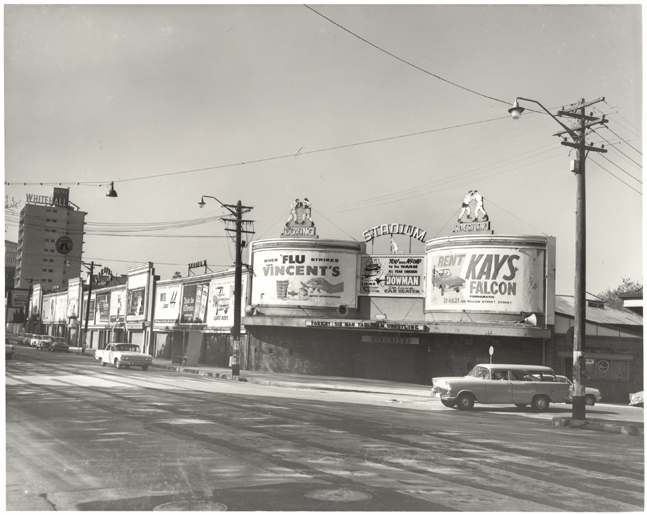
The sound systems available in all the venues for the Beatles concerts were fairly basic – essentially the same facilities used for wrestling, boxing and revivalist meetings. Glenn A. Baker quotes Ron Blackmore, who later supervised PAs for the Rolling Stones 1973 concerts, who explained
“there was one amplifier, of about 100-150 watts, into which ran an average of 8 microphones.. there was no mixer : the singer balanced the sound by moving back and forward on the mic. There was a volume knob and a tone knob and that was it. All this was usually locked away in a back room somewhere, although at the Sydney Stadium it was under the stage. Out front it was even worse. At the Stadium, there was a cluster of tin AWA horns on each of four posts which were aimed at the four seating sections. This was what the Beatles’ voices were carried through, though it wasn’t altogether as bad as it sounds. Groups in the sixties learned their harmonies so well that they could be put in separate rooms and still keep in time with the other guys. The Beatles harmonies weren’t bad at all”. xxix
Dressing rooms at all the concert venues were similarly primitive - draughty wooden boxes, reeking of sweat and liniment - the only exception was the Sydney Stadium where Dawn Miller, wife of Sydney Stadium manager Harry Miller, had redecorated backstage prior to the concerts. Walls were painted, two lounge suites and coffee table installed and curtains hung.
There was a suggestion that this may have been done to divert the Beatles’ attention away from the ‘curse of the Sydney Stadium – the revolving stage’ which was built on top of the boxing ring. Ron Blackmore explained: “Because the microphone cables ran up a centre pole, the stage couldn’t go around continually in one direction. It went one turn and then a little man by side-stage with a lever sent it back the other way so that the cables could untangle”. xxx Perhaps this was just as well – in 1954, in the middle of jazz trumpeter Louis Armstrong’s first Australian performance, dense smoke billowed from under the stage, caused by the electric motor which drove the revolving stage becoming red-hot and threatening to set the stage alight. xxxi
The Sydney Stadium was demolished in 1970 to make way for the Eastern Suburbs Railway.
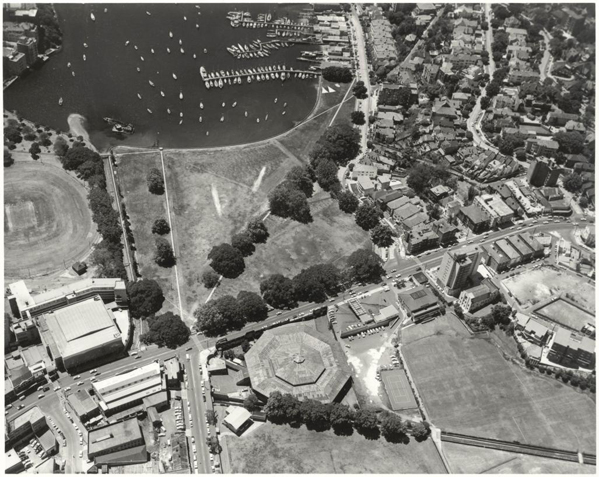
Significance
In 2013 the Museum of Applied Arts and Sciences (the Powerhouse Museum) mounted an exhibition ‘The Beatles in Australia’ chronicling the tour’s lasting impact on Australian music and culture.
“The eruption of Beatlemania in Australia was more intense than anywhere in the world. For thirteen days in 1964 the nation was held in a kind of euphoria, captivated by the talent, the songs and the charm of the Fab Four on their concert tour” The Beatles in Australia , MAAS exhibition 2013-14
Terry Smith quotes rock music journalist and commentator Glenn A. Baker xxxii , on why The Beatles caused such an upheaval in Australia:
“The Beatles were a sign from above, a skewer to lance the boil of stifling traditionalism. They had the power to link us, a colonial backwater, to a big wide world of fads and fashions and uninhibited excitement. The Beatles, their presence and their lingering influence, became a catalyst for the suppressed frustrations of kids who had begun to realise that unquestioned obedience to anyone older was no longer a sacred law. It liberated young Australians…”
Peter Cox, who curated the MAAS exhibition, observed in his 2018 essay, ‘The Beatles in Australia’ , that "The tour was a major event for Australia in the 1960s. It kicked into gear that tumultuous decade, sparking an exciting period in music and culture". He noted that The Beatles visit to Australia influenced a generation of Australians to travel to the UK at a time when London was becoming 'the font of youth fashion and popular culture'. The Beatles tour also paved the way for visits by other English groups. "This ‘British invasion’ caused a sudden and dramatic shift in Australian music. A new generation of local groups, most made up of recent migrants, including The Easybeats, The Bee Gees, Billy Thorpe & the Aztecs, MPD Ltd and The Twilights, led an Australian ‘beat boom’ in the mid-1960s”.
The Beatles had arrived in Australia at a time when ‘overseas travel was prohibitively expensive, and so were international phone calls’ - not everyone owned a television. The Beatles concerts provided a link to the emerging counter-culture of the 1960s and a ‘once in a lifetime celebration of youthful rebellion’ xxxiii for thousands of Sydney-siders.
Baker, Glenn A. The Beatles down under : the 1964 Australia and New Zealand tour. Glebe : NSW, 1982
Coupe, Stuart. The promoters : inside stories from the Australian rock industry . Sydney : Hodder Headline Australia, 2003.
Gould, Jonathan, Can't buy me love : the Beatles, Britain, and America . New York : Harmony Books, c2007.
Hayward, Mark. The Beatles in Australia. Sydney : New Holland Publishers (Australia) Pty Ltd, 2005.
Smith, Terry, The old tin shed : Sydney Stadium 1908-1970 , North Sydney, N.S.W. : Eric Spilsted Publishing, c1999. [Chapter 8 Beatlemania]
https://maas.museum/event/the-beatles-in-australia/
https://maas.museum/the-beatles-in-australia-essay/
https://dictionaryofsydney.org/entry/the_beatles_in_sydney
i The Sydney Stadium, known as 'The Tin Shed', was an iconic large-capacity boxing and concert venue that stood on the corner of New South Head Road and Neild Avenue, Rushcutters Bay, until it was demolished in 1970 to make way for the Eastern Suburbs Railway.
ii Glenn A. Baker The Beatles down under : the 1964 Australia and New Zealand tour, Glebe : NSW, 1982, p. 11
iii Baker, Glenn A. p. 12
iv https://www.heraldsun.com.au/news/victoria/the-beatles-in-australia-50-years-on-how-four-days-changed-melbourne/news-story/5de26eafc62b02396670d7aaf9615f59 .
v Gould, Jonathan, Can't buy me love : the Beatles, Britain, and America . New York : Harmony Books, c2007 p. 21
vi NAA Incoming Passenger Cards NAA: A1225, 9-12 JUNE 1964 NSW BEATLES
vii https://www.smh.com.au/entertainment/the-beatles-let-it-be-in-australia-1964-20140606-zrvui.html
viii Baker, Glenn A., p. 24
ix Baker, Glenn A., p. 14
x https://maas.museum/the-beatles-in-australia-essay/
xi Average Weekly Male earnings in NSW for 1965-1966 as reported by the ABS were about $58.00 (£27.50) https://www.abs.gov.au/statistics/labour/earnings-and-work-hours/average-weekly-earnings-australia
xii Baker, Glenn A., p. 72
xiii Baker, Glenn A., p. 100
xiv Gould, Jonathan, p. 26
xv Gould, Jonathan, p. 57
xvi Gould, Jonathan, p. 273
xvii https://www.rockhall.com/inductees/beatles
xviii Gould, Jonathan, p. 602
xix https://www.rockhall.com/inductees/paul-mccartney
xx A tweet from the Royal Family’s official Twitter page read: “Congratulations Sir @PaulMcCartney who has been made a #CompanionofHonour at Buckingham Palace today for his lasting contribution to music in the UK and Worldwide.”
xxi Gould, Jonathan, p. 127
xxii https://www.classicdrummerhalloffame.com/ringo-starr
xxiii https://www.rockhall.com/inductees/ringo-starr
xxiv https://www.gov.uk/government/news/the-new-years-honours-list-2018 and https://www.bbc.com/news/entertainment-arts-43472196
xxv Baker, Glenn A., p. 11
xxvi Coupe, Stuart. The promoters : inside stories from the Australian rock industry . Sydney : Hodder Headline Australia, 2003. Part 2: The Beatles and Brodziak
xxvii In 2019, Woollahra Council unveiled a plaque commemorating the December 1908 bout
xxviii No title (1912, July 29). Construction : Weekly Supplement to Building (Sydney, NSW : 1909 - 1914) , p. 8. http://nla.gov.au/nla.news-article234759831
xxix Ron Blackmore as quoted in Baker, Glenn A., p. 94
xxx Ron Blackmore as quoted in Baker, Glenn A., p. 96
xxxi Louis Armstrong And Band Get A Hot Reception (1954, October 28). The Sydney Morning Herald (NSW : 1842 - 1954) , p. 1. http://nla.gov.au/nla.news-article18448805
xxxii From Glenn A. Baker, Places and Barely Human Race’ , 1995, as quoted in Smith, Terry, The old tin shed, p 101
xxxiii Robin Gerster and Jan Bassett, Seizures of Youth, The Sixties and Australia . South Yarra, Victoria: Hyland House, 1991, p 4, as quoted in Dictionary of Sydney - The Beatles in Sydney
New plaques are added based on nominations from the community, which are then assessed against selection criteria and researched by a Local History Librarian. Find out more and nominate a person or event for a plaque.
We will keep fighting for all libraries - stand with us!
Internet Archive Audio

- This Just In
- Grateful Dead
- Old Time Radio
- 78 RPMs and Cylinder Recordings
- Audio Books & Poetry
- Computers, Technology and Science
- Music, Arts & Culture
- News & Public Affairs
- Spirituality & Religion
- Radio News Archive

- Flickr Commons
- Occupy Wall Street Flickr
- NASA Images
- Solar System Collection
- Ames Research Center

- All Software
- Old School Emulation
- MS-DOS Games
- Historical Software
- Classic PC Games
- Software Library
- Kodi Archive and Support File
- Vintage Software
- CD-ROM Software
- CD-ROM Software Library
- Software Sites
- Tucows Software Library
- Shareware CD-ROMs
- Software Capsules Compilation
- CD-ROM Images
- ZX Spectrum
- DOOM Level CD

- Smithsonian Libraries
- FEDLINK (US)
- Lincoln Collection
- American Libraries
- Canadian Libraries
- Universal Library
- Project Gutenberg
- Children's Library
- Biodiversity Heritage Library
- Books by Language
- Additional Collections

- Prelinger Archives
- Democracy Now!
- Occupy Wall Street
- TV NSA Clip Library
- Animation & Cartoons
- Arts & Music
- Computers & Technology
- Cultural & Academic Films
- Ephemeral Films
- Sports Videos
- Videogame Videos
- Youth Media
Search the history of over 866 billion web pages on the Internet.
Mobile Apps
- Wayback Machine (iOS)
- Wayback Machine (Android)
Browser Extensions
Archive-it subscription.
- Explore the Collections
- Build Collections
Save Page Now
Capture a web page as it appears now for use as a trusted citation in the future.
Please enter a valid web address
- Donate Donate icon An illustration of a heart shape
The Beatles down under : the 1964 Australia & New Zealand tour
Bookreader item preview, share or embed this item, flag this item for.
- Graphic Violence
- Explicit Sexual Content
- Hate Speech
- Misinformation/Disinformation
- Marketing/Phishing/Advertising
- Misleading/Inaccurate/Missing Metadata
![[WorldCat (this item)] [WorldCat (this item)]](https://archive.org/images/worldcat-small.png)
plus-circle Add Review comment Reviews
321 Previews
6 Favorites
DOWNLOAD OPTIONS
No suitable files to display here.
EPUB and PDF access not available for this item.
IN COLLECTIONS
Uploaded by station21.cebu on April 11, 2019
SIMILAR ITEMS (based on metadata)
- Statistics Stats
- You are here:
- Beatles, The
- June 16, 1964 Setlist
The Beatles Setlist at Festival Hall, Melbourne, Australia
- Edit setlist songs
- Edit venue & date
- Edit set times
- Add to festival
- Report setlist
Tour: 1964 World Tour Tour statistics Add setlist
- I Saw Her Standing There Play Video
- I Want to Hold Your Hand Play Video
- You Can't Do That Play Video
- All My Loving Play Video
- She Loves You Play Video
- Till There Was You ( Meredith Willson cover) Play Video
- Roll Over Beethoven ( Chuck Berry cover) Play Video
- Can't Buy Me Love Play Video
- This Boy Play Video
- Long Tall Sally ( Little Richard cover) Play Video
Note: Early Show
Edits and Comments
8 activities (last edit by ExecutiveChimp , 10 Nov 2015, 06:50 Etc/UTC )
Songs on Albums
- I Want to Hold Your Hand
- She Loves You
- Long Tall Sally by Little Richard
- Roll Over Beethoven by Chuck Berry
- Till There Was You by Meredith Willson
- Can't Buy Me Love
- You Can't Do That
- I Saw Her Standing There
- All My Loving
Complete Album stats
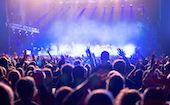
The Beatles
More from this artist.
- More Setlists
- Artist Statistics
- Add setlist
Related News
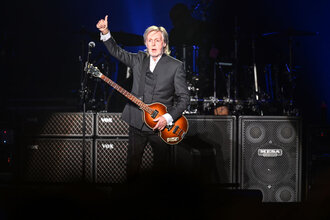
Paul McCartney Kicks Off Got Back Tour in Australia
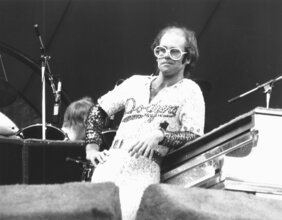
Setlist History: Major League Baseball Stadiums As Rock Venues
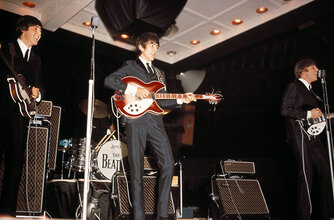
Setlist History: The Beatles Kick Off Full North American Tour
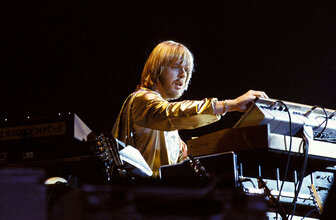
Moog's Influence on The Beatles, The Beach Boys, and Dr. Dre
Festival hall.
- The Beatles This Setlist Add time Add time
- The Beatles Add time Add time
- Sounds Incorporated Add time Add time
- Johnny Devlin Add time Add time
- Johnny Chester Add time Add time
- The Phantoms Add time Add time
The Beatles Gig Timeline
- Jun 15 1964 Festival Hall Melbourne, Australia Add time Add time
- Jun 16 1964 Festival Hall This Setlist Melbourne, Australia Add time Add time
- Jun 16 1964 Festival Hall Melbourne, Australia Add time Add time
- Jun 17 1964 Festival Hall Melbourne, Australia Add time Add time
Concert People
Share or embed this setlist.
Use this setlist for your event review and get all updates automatically!
<div style="text-align: center;" class="setlistImage"><a href="https://www.setlist.fm/setlist/the-beatles/1964/festival-hall-melbourne-australia-63dae22b.html" title="The Beatles Setlist Festival Hall, Melbourne, Australia 1964, 1964 World Tour" target="_blank"><img src="https://www.setlist.fm/widgets/setlist-image-v1?id=63dae22b" alt="The Beatles Setlist Festival Hall, Melbourne, Australia 1964, 1964 World Tour" style="border: 0;" /></a> <div><a href="https://www.setlist.fm/edit?setlist=63dae22b&step=song">Edit this setlist</a> | <a href="https://www.setlist.fm/setlists/the-beatles-23d6a88b.html">More The Beatles setlists</a></div></div>
Last.fm Event Review
[url=https://www.setlist.fm/setlist/the-beatles/1964/festival-hall-melbourne-australia-63dae22b.html][img]https://www.setlist.fm/widgets/setlist-image-v1?id=63dae22b[/img][/url] [url=https://www.setlist.fm/edit?setlist=63dae22b&step=song]Edit this setlist[/url] | [url=https://www.setlist.fm/setlists/the-beatles-23d6a88b.html]More The Beatles setlists[/url]
Tour Update
Marquee memories: the dandy warhols.
- The Dandy Warhols
- Apr 22, 2024
- Apr 21, 2024
- Apr 20, 2024
- Apr 19, 2024
- Apr 18, 2024
- Apr 17, 2024
- FAQ | Help | About
- Terms of Service
- Ad Choices | Privacy Policy
- Feature requests
- Songtexte.com

The Beatles 1964 Australasian tour: "Welcome to Australia, which one am I talking to?"
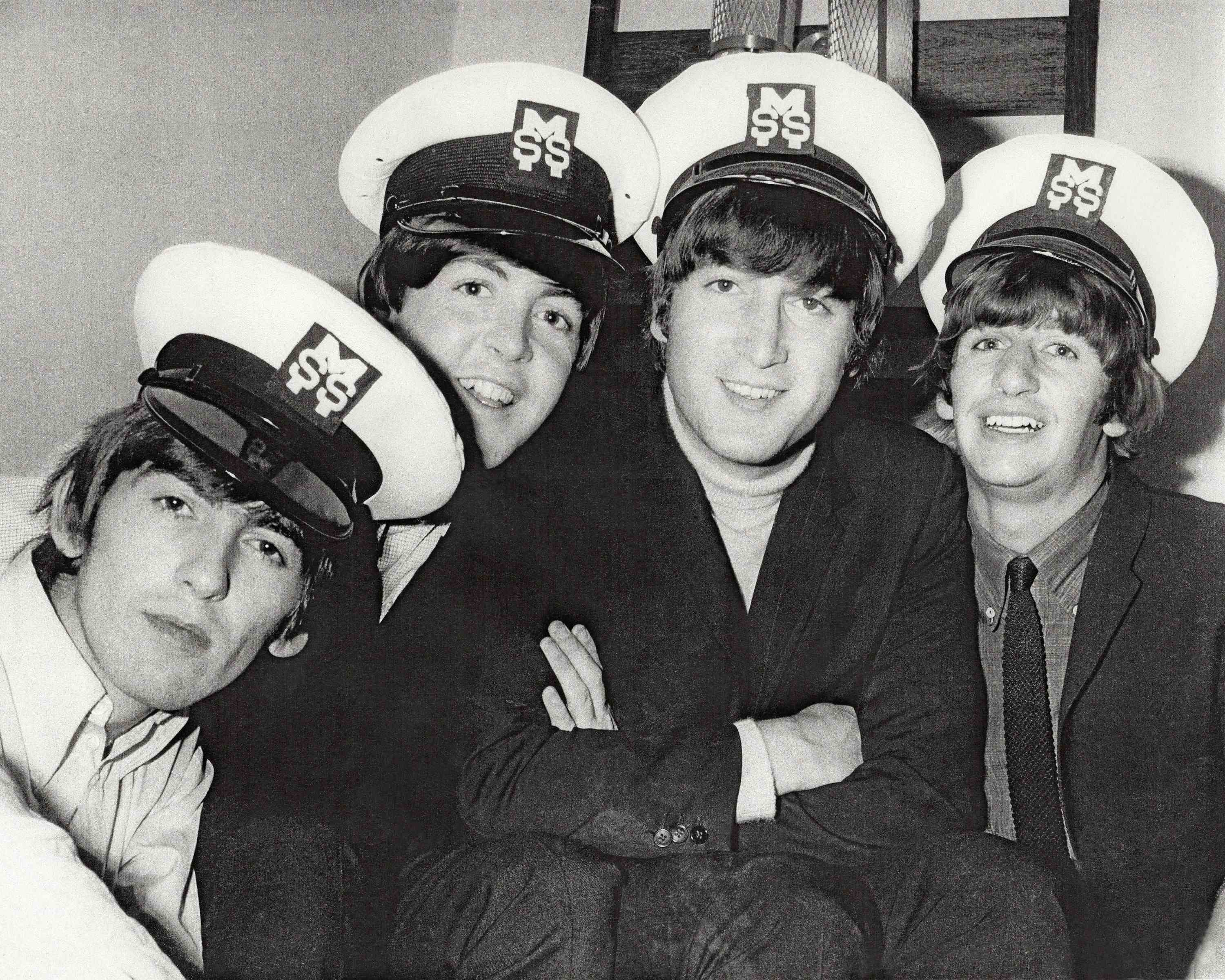
Join Jeff Black, one of Australia’s foremost Beatles experts and memorabilia collectors. Relive the excitement of the Beatles Australasian tour in 1964. Jeff will share a selection of his rare and precious collection at Logan Central and Logan West libraries throughout June. He will complement these displays with informative talks presented at both library locations. For those who lived it, the memories will come flooding back! Hear why The Beatles were so popular and how they revolutionised music and culture. Memorabilia on display at Logan Central and Logan West libraries from Monday 3 June to Saturday 29 June.
- Staff Recommendations
- Suggest a Purchase
- Hours & Locations
- Local Studies Room
- Tech. Learn. Create. Lounge
- Accessibility Centre
- Computers and Technology
Staff Access
Thankyou for your feedback.

- Terms of Use
- Ask a Librarian
- Please Please Me (1963)
- The Mersey Sound (1964)
- With The Beatles (1964)
- A Hard Day's Night (1964)
- Beatles For Sale (1965)
- Help! (1965)
- Rubber Soul (1966)
- Greatest Hits Volume 1 (1966)
- Revolver (1966)
- Greatest Hits Volume 2 (1967)
- Sgt. Pepper's Lonely Hearts Club Band (1967)
- A Collection Of Beatles Oldies (1968)
- The Beatles (1968)
- Yellow Submarine (1969)
- Magical Mystery Tour And Other Splendid Hits (1969)
- Abbey Road (1969)
- The Beatles In Hamburg (1970)
- Hey, Jude! (1970)
- Let It Be (1970)
- The Essential Beatles (1972)
- Australian 10th Anniversary 1963-1973 Souvenir Presentation (1973)
- The Beatles / 1962-1966 (1973)
- The Beatles / 1967-1970 (1973)
- Rock 'N' Roll Music (1976)
- The Beatles Tapes (1976)
- The Beatles At The Hollywood Bowl (1977)
- Live! At The Star-Club in Hamburg, Germany; 1962. (1977)
- Love Songs (1977)
- The Beatles Collection (1978 Box Set)
- Rarities (UK) (1978)
- Rarities (US) (1980)
- Rock Legends (1980)
- The Beatles Box (1981)
- The Beatles Ballads (1981)
- A Hard Day's Night Original Motion Picture Sound Track (1981)
- Reel Music (1982)
- Historic Sessions (1982)
- The Number Ones (1983)
- Past Masters Volumes One & Two (1988)
- Twist And Shout (1963)
- The Beatles Hits (1964)
- The Beatles No. 1 (1964)
- All My Loving (1964)
- The Beatles With Tony Sheridan (1964)
- "Requests" (1964)
- More Requests! (1964)
- Further Requests (1964)
- A Hard Day's Night - Extracts From The Film (1964)
- With The Beatles (1965)
- A Hard Day's Night - Extracts From The Album (1965)
- Beatles For Sale (No. 2) (1965)
- Yesterday (1966)
- Nowhere Man (1966)
- Help! (1967)
- Norwegian Wood (1967)
- Magical Mystery Tour (1968 Mono)
- Magical Mystery Tour (1968 Stereo)
- Penny Lane (1968)
- Singles
- 8 Track Cartridge
- Reel-To-Reel Tape
- Production Master Tapes
- Discography
- An Overview Of Australian Beatles Records
- Australian Beatles Records Rarity Guide
- Label Styles - LPs
- Label Styles - EPs
- Label Styles - Singles
- Made In Australia
- Royalty Stamps And Publishing
- Official EMI Imports
- Variations Explained
- Label Order Explained
- Latest Content Updates
- Frequently Asked Questions
- Site Credits
- Contact Admin
- International edition
- Australia edition
- Europe edition

‘An explosion of screaming and hysteria’: US fans on how they were introduced to the Beatles
Four Americans on what it felt like to be swept up in Beatlemania, and reflecting on the band’s impact on their lives
W hat Janet DiGangi recalls most vividly about the day the Beatles came to town is eating cake and ice-cream with furious impatience. It was 12 September 1964, and DiGangi was 12, living in Boston, Massachusetts, the oldest of seven siblings. The Beatles were about to play Boston Garden but the family couldn’t leave until they’d celebrated her brother Peter’s second birthday with candles and presents.
“I was furious, because I didn’t want to be late,” recalls DiGangi, now 72. She had saved up all her babysitting money to buy the band’s second US album, Meet the Beatles! “I was so excited.” Thankfully, DiGangi made it to the show on time. It was “electric”, and sent fans wild. “It was just an explosion of screaming and hysteria,” she says.
Like many Americans who watched the Beatles arrive in the US – either on 9 February 1964 on their first Ed Sullivan Show, or those who caught their North American tour later that year – the experience for DiGangi fostered a lifelong love and fascination with the band from Liverpool. As she grew up from a schoolgirl to an adolescent to a young woman, she tagged along as the band’s sound developed, from the boys next door of A Hard Day’s Night to the mop-haired artists of Revolver to the mature and creatively fractious White Album.
Next month marks 60 years since the Beatles secured all the top five slots on the Billboard Hot 100 on 4 April 1964 – the height of Beatlemania in the US. “To look back 60 years from now, I remember things so vividly,” DiGangi says. “I totally remember watching them on television and just crying.”
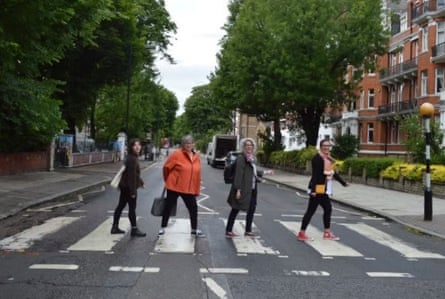
DiGangi, whose favourite album is Rubber Soul, has passed on her passion for the band to the next generation, taking her niece to Abbey Road in London in 2017. “It was just as thrilling for me then as if it were 1969,” she says.
For many fans in the US, encountering the Beatles as teenagers sparked a lifelong desire to play music. Michael Shaw, a 76-year-old in Atlanta, Georgia, says he was part of the manic crowd of flailing limbs that greeted the band at Miami airport when they arrived for their second Ed Sullivan appearance, on 16 February 1964. Shaw was 16 and played lead guitar in a band called the Outcasts.
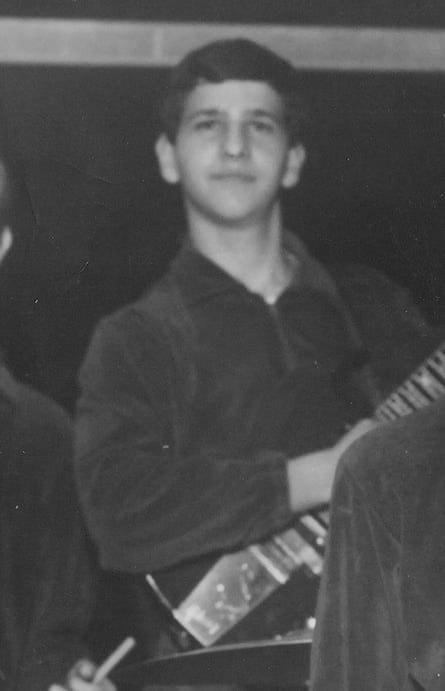
“The Beatles and the rest of the British invasion absolutely changed music and the style of music we were playing,” he says.
“I used to practise guitar four hours a day at that time, and I would sit down with my latest LP and play a song over and over trying to learn the chords,” Shaw says. As the Beatles’ sound matured, it was hard to keep up with George Harrison’s evolving style: “It really made me stretch,” he adds . Six decades on, Shaw – who says he owns a Höfner bass guitar signed by Harrison and Paul McCartney – is still in a band. They play southern rock. “I keep on trying to get my bandmates to cover some Beatles songs,” he says.

Ruth Yost, 71, says she “watched the Beatles on Ed Sullivan and felt the world was changing”. Aged 12, she took along binoculars when the Beatles came to Indianapolis, Indiana, on 3 September 1964.
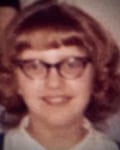
Yost could hardly hear the music over the screams but it was enough to be in the same room with the Beatles. “I didn’t feel like myself, I felt like somebody else,” she says. “It was almost frightening, to think here I was.”
Yost became a collector of all things Beatles; her son now keeps her original LPs safe. Yost says she was a hesitant girl, the baby of a large family, and saw something of herself in George Harrison. She even dressed up as him for Halloween in 1964. “I always identified with George,” she says. “He seemed so sweet.”
Yost says the band got her through the turbulence of adolescence. “I feel like the Beatles – their music, their humour – helped a shy junior-high girl grow up through high school,” she says. The band broke up in April 1970, the year Yost graduated. “It was as if they stuck together to see me make it,” she says.

Susan Bendinelli says she saw the Beatles at San Francisco’s Cow Palace on 19 August 1964 with her older brother when she was 10. “They just had me from then on,” she says. “They had such an amazing energy, and their songs were like nothing we’d ever heard,” adding: “It was black-and-white to Technicolor.”
The seats were up in the gods and all she could see was “these four little Beatles on a stage”. She recalls being frustrated that the screaming drowned out the music. At the concert, Bendinelli, now 69, got a set of Beatles figurines – she still has Paul McCartney and Ringo Starr.
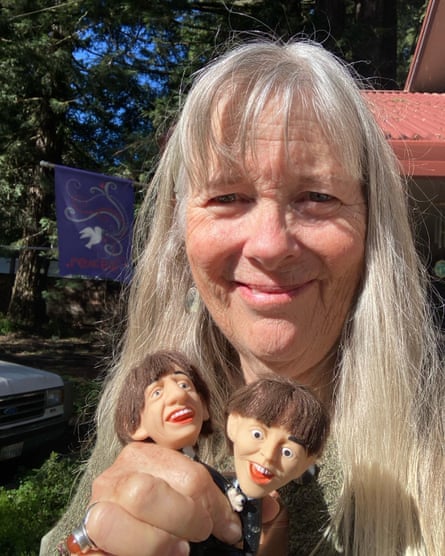
The Beatles helped her generation “find our voices”, she says. As she grew up, and the Beatles themselves became more political engaged, Bendinelli got involved in the anti-nuclear and anti-war movements, protesting against the US war in Vietnam, and promoting sustainability through Earth Day and local environmental activism.
“All through my life I’ve been an activist. And I don’t know if I would have done that if I hadn’t had those experiences when I was really young and watched the Beatles become activists as well,” she says. “They definitely created a foundation for me that I still feel I walk on.”
- The Beatles
Most viewed
More From Forbes
One of the beatles’ most famous songs reaches a new high on the hot 100.
- Share to Facebook
- Share to Twitter
- Share to Linkedin
2nd July 1964: The Beatles (from left to right, John Lennon (1940 - 1980), George Harrison (1943 - ... [+] 2001), Paul McCartney and Ringo Starr) arrive back at London Airport after their Australian tour. (Photo by Fox Photos/Getty Images)
The Beatles were one of the most successful musical acts when it came to collecting Hot 100 hits during their heyday. The band pushed pretty much every single they released to the ranking of the most-consumed songs in the U.S. for nearly a decade. While many of their beloved smashes reached the competitive tally, plenty of other well-known tunes from the group never had a chance to shine on the chart, based on how it was arranged at the time.
This week, one of The Beatles’ most recognizable songs finds a home on the Hot 100. It does so thanks to an inventive and beautiful cover from one of the biggest musical stars in the world—and it reaches a new peak thanks to the reworking.
A cover of The Beatles’ “Blackbird” by Beyoncé debuts on the Hot 100 this week. The tune opens at No. 27 on the ranking of the most-consumed songs in the U.S.
Beyoncé’s take on the Beatles classic sticks pretty close to the original, though she does make it her own in some ways. For starters, she changed the name, but only slightly. To help differentiate it from the classic, and to keep it in the same format as her other tracks on her latest album, she’s added a second "i," calling it “Blackbiird.”
Also, Beyoncé’s “Blackbiird” is not a solo track. She invited several Black women in the country world to join her on the tune, helping all of them reach the Hot 100 for the first time. Her song features Tanner Adell, Brittney Spencer, Tiera Kennedy, and Reyna Roberts.
The original Beatles “Blackbird” was credited to the band, but it was really a solitary effort. Paul McCartney wrote it, and he both sang all the lyrics and played all the instruments.
Beyoncé’s version of “Blackbird” is not the first to reach the Hot 100, but it’s now the highest-rising. The cast of the TV show Glee covered the tune, and their rendition peaked at No. 37. The Beatles’ track never landed on the chart, as it wasn’t spun off as a single. Back in the ‘60s, only singles reached the Hot 100, though now, because of digital sales of individual tunes and streaming, any cut is eligible for the list.
Best High-Yield Savings Accounts Of 2024
Best 5% interest savings accounts of 2024.
- Editorial Standards
- Reprints & Permissions

IMAGES
VIDEO
COMMENTS
The Beatles 1964 world tour was the Beatles' first world tour, launched after their 1964 UK tour. The reception was enthusiastic, with The Spectator describing it as "hysterical". It was followed by their subsequent North American tour in August that year. ... The Beatles Down Under: the 1964 Australia & New Zealand tour. Glebe, NSW Australia ...
The Beatles' 1964 tour of Australia. The Beatles' 1964 tour of Australia was a several week tour performed by the British rock band the Beatles as a part of their 1964 world tour. [1] [page needed] The tour was their first and only tour of Australia. The tour was notable particularly because Jimmie Nicol had replaced a hospitalised Ringo Starr.
3rd Upload attemptThis is currently the most complete best quality upload of the Full 1964 Concert in Melbourne (and finally in correct order). Video has bee...
It was 50 years ago that The Beatles made their one and only tour of Australia. The Beatles touched down in Sydney on June 11, 1964 and for an amazing 13 day...
The Beatles landed in Australia at Sydney's Mascot airport just before 7.45am on Thursday 11 June 1964. Their Australian tour consisted of 20 concerts. There were two shows performed each playing day, at 6pm and 8.45pm, as follows: Adelaide (4 concerts) - Friday 12 June and Saturday 13 June. Melbourne (6 concerts) - Monday 15 June, Tuesday 16 ...
The Beatles wave to the crowd below from the balcony of the Southern Cross Hotel in Melbourne, during their Australia/NZ tour, June 1964. "I was brought in especially for the tour," he recalls ...
The Beatles live: Sydney Stadium, Sydney. The Beatles had arrived in Sydney, Australia on 11 June 1964, but didn't perform there until this day, 18 June. They arrived in the city by aeroplane at 7.40am. Around 1,200 fans greeted them at the airport, along with 300 police officers. The Beatles were taken to their suite at the Sheraton Hotel ...
W hen the Beatles arrived in Australia in 1964 for their first and only tour of the country, huge crowds greeted them everywhere they went. But one of the biggest turnouts was in Adelaide, where ...
Get the The Beatles Setlist of the concert at Sydney Stadium, Sydney, Australia on June 18, 1964 from the 1964 World Tour and other The Beatles Setlists for free on setlist.fm! ... The Beatles Kick Off Full North American Tour. Aug 18, 2023. Moog's Influence on The Beatles, The Beach Boys, and Dr. Dre. Aug 14, 2023. Jun 18 1964. Sydney Stadium
In June 1964, The Beatles made their only tour to Australia. John Lennon, Paul McCartney, George Harrison and stand-in drummer Jimmy Nicol were greeted in Ad...
The Beatles' final two shows in Melbourne, Australia, took place on 17 June 1964. In the afternoon George Harrison went driving in an MG in the Dandenong Mountains with tour organiser Lloyd Ravenscroft. Concerned with more important matters, John Lennon, Paul McCartney, and Ringo Starr had their hair cut in their hotel, the Southern Cross. This was The Beatles' last of three consecutive ...
The Beatles' 1964 world tour ended on 30 June 1964, with two shows at the Festival Hall in Brisbane. Each of the concerts was seen by 5,500 fans. During the day they took two hire cars to the Gold Coast, where they spent time relaxing on a stretch of sand between Broadbeach and Surfers Paradise. The Beatles returned to Lennons Hotel in ...
Australian publishing house Woodslane Press have announced a new book entitled When We Was Fab: Inside The Beatles ' Australasian Tour 1964. As its title suggests, the book documents the first ...
April 2, 2024. By David James Young. Australian publishing house Woodslane Press have announced a new book entitled When We Was Fab: Inside The Beatles ' Australasian Tour 1964. As its title ...
The Beatles Concerts at the Sydney Stadium 18-20 June 1964. In June 1964, 'Beatlemania' arrived in Sydney. The Beatles performed six concerts at the Sydney Stadium i, Rushcutters Bay as part of a two week tour of Australia and New Zealand.. For all the charisma the four emitted, the real stars of the tour were the hundreds of thousands of ordinary people who screamed in public and viewed in ...
The Beatles 1964 Australian tour 16 Images The Beatles one and only tour of Australia, which started 50 years ago when they arrived in Sydney in pouring rain on 11 June 1964, has become an event ...
For three weeks, the Beatles turned Australia and New Zealand upside-down as they performed 32 concerts in eight cities.Added videos of missing songs from ot...
The Beatles down under : the 1964 Australia & New Zealand tour by Baker, Glenn A., 1952-Publication date 1985 ... "Beatles' Australian discography": pages 118-119 Access-restricted-item true Addeddate 2019-04-11 07:57:00 Associated-names Dilernia, Roger Bookplateleaf 0004 ...
Get the The Beatles Setlist of the concert at Festival Hall, Melbourne, Australia on June 16, 1964 from the 1964 World Tour and other The Beatles Setlists for free on setlist.fm! ... The Beatles Kick Off Full North American Tour. Aug 18, 2023. Moog's Influence on The Beatles, The Beach Boys, and Dr. Dre. Aug 14, 2023. Jun 16 1964. Festival Hall
1-20. The Beatles -. This Boy. 1-21. The Beatles -. Twist And Shout. Late Concert (Sixth) At Festival Hall, Dudley Street, West Melbourne. 17th June 1964. 2-01.
The English rock group the Beatles toured the United States and Canada between 19 August and 20 September 1964. The 32 concerts comprised the second stage of a world tour that started with the band's tour of Europe, Hong Kong, and Australia and finished with their UK Autumn tour. The shows in the United States were a return to the country after ...
Join Jeff Black, one of Australia's foremost Beatles experts and memorabilia collectors. Relive the excitement of the Beatles Australasian tour in 1964. Jeff will share a selection of his rare and precious collection at Logan Central and Logan West libraries throughout June. He will complement these displays with informative talks presented ...
I Am The Platypus is host to the largest and most comprehensive archive of Australian Beatles vinyl LP, ... With The Beatles (1964) A Hard Day's Night (1964) Beatles For Sale (1965) ... Yellow Submarine (1969) Magical Mystery Tour And Other Splendid Hits (1969) Abbey Road (1969) The Beatles In Hamburg (1970) Hey, Jude! (1970) Let It Be (1970 ...
Like many Americans who watched the Beatles arrive in the US - either on 9 February 1964 on their first Ed Sullivan Show, or those who caught their North American tour later that year - the ...
2nd July 1964: The Beatles (from left to right, John Lennon (1940 - 1980), George Harrison ... Paul McCartney and Ringo Starr) arrive back at London Airport after their Australian tour. (Photo by ...